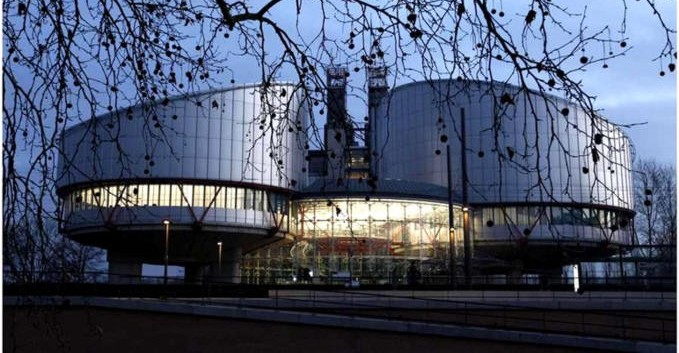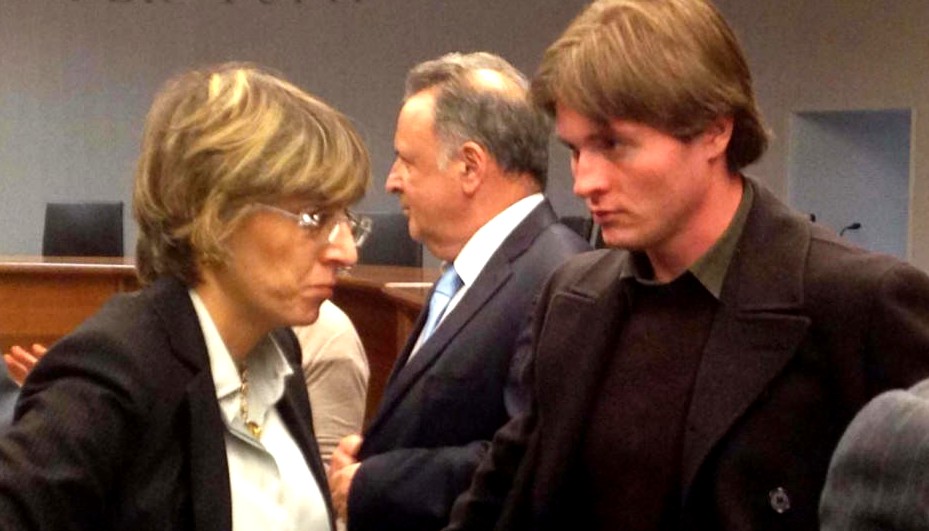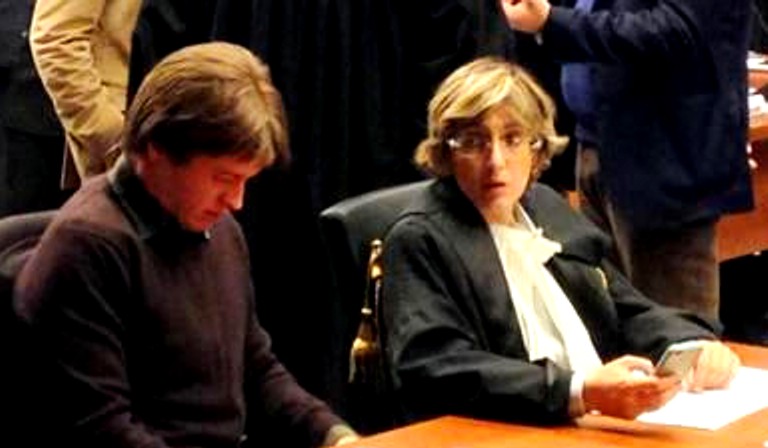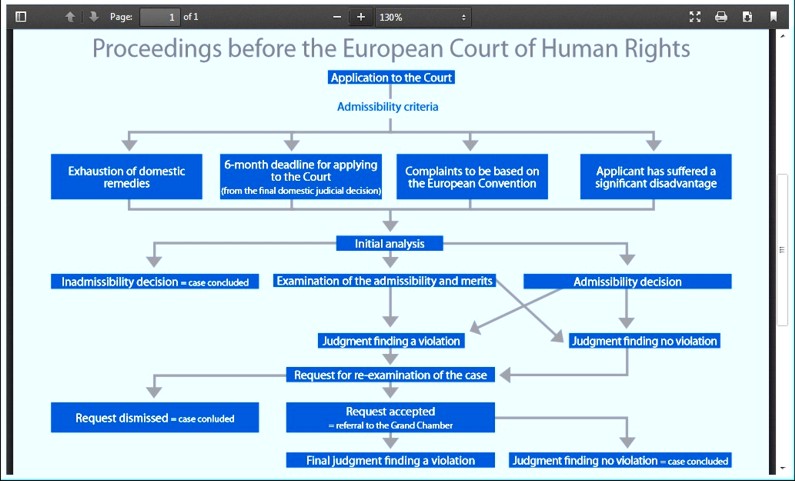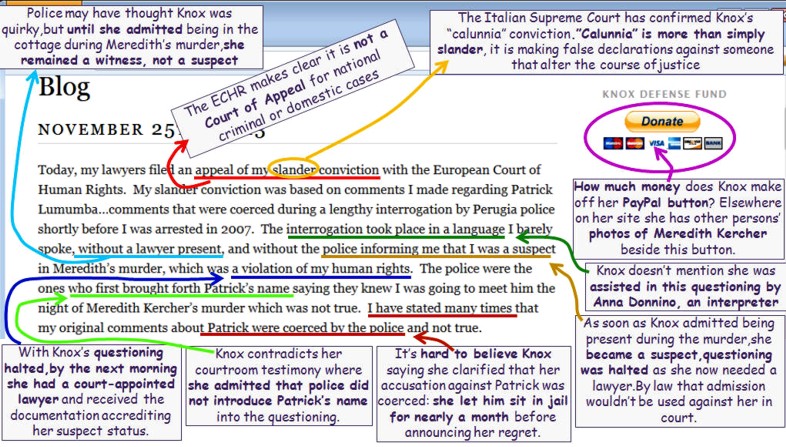
Monday, January 06, 2014
Curious Parallels Between Scott Peterson And Amanda “I Am Not A Psychopath” Knox
Posted by giustizia
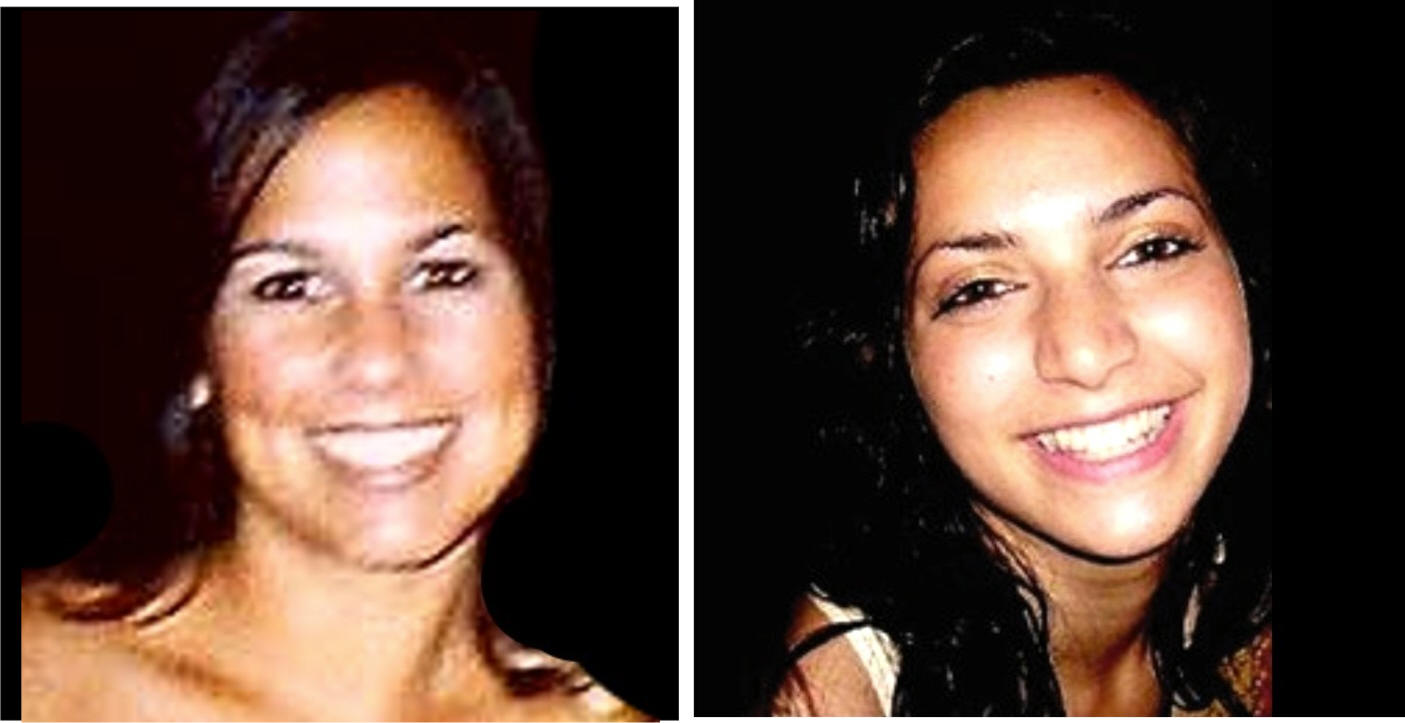
[Above: Laci Peterson and Meredith Kercher, the victims in the two cruel crimes]
1. The Violent Deaths Of Laci Peterson and Meredith Kercher
Laci Peterson was soon to give birth in California in December of 2002. On Christmas Eve, her husband Scott reported her missing. In April of the following year, her body and the body of her unborn son Connor were discovered in the San Francisco Bay.
Five years later, in Italy, on 2 November 2007, foreign study student Amanda Knox was at her rental home with her Italian lover Raffaele Sollecito in Perugia, Italy, when the postal police arrived early one morning to return some cell phones traced to her flatmates; the phones had been found dumped in a nearby garden.
Shortly after, the shocking discovery was made that her flat mate Meredith Kercher had been murdered.
2. Parallels Between Knox and Peterson In Their Personalities, Crimes And Court Cases
There is a number of striking parallels between the behaviors of Amanda Knox and Scott Peterson and their alleged crimes and convictions.
The horrific murders of two beautiful young women (one almost at the end of the full-term pregnancy of her first child) unleashed in each case a maelstrom of publicity rarely seen in search of the murderer.
When arrests were made, there also came the stunning revelation in each case that the accused was well-known to the victim ““ in Laci’s case, it was her husband, Scott Peterson; in Meredith’s case, it was her roommate, Amanda Knox.
Ultimately, three people were arrested for the murder of Meredith (as we know, the fourth person arrested, Patrick Lumumba, falsely accused by Knox as Meredith’s murderer, was released when his solid alibi was proven). Of the three people arrested for the murder of Meredith Kercher, evidence suggested to prosecutors that Amanda Knox was the instigator of the crime.
In each trial, the defendant presented a seemingly normal and middle-class appearance. Neither defendant had a significant history of violence or widely-obvious mental illness. Their families insist on their innocence.
Yet both were convicted of brutal murders (and both now fight their convictions on appeal).
Knox and Peterson were each described by casual acquaintances, neighbors and friends as nice, regular people.
Ann Bird, Peterson’s half-sister, described him as being “charismatic, charming, courteous, polite.” On Dateline NBC television, a friend of Amanda Knox described her as being “generous, kind, genuine, optimistic, bubbly. Pretty much all the good words that you can find in a dictionary, she was.”
But they proved superficial assessments that in fact really only scratched the surface.
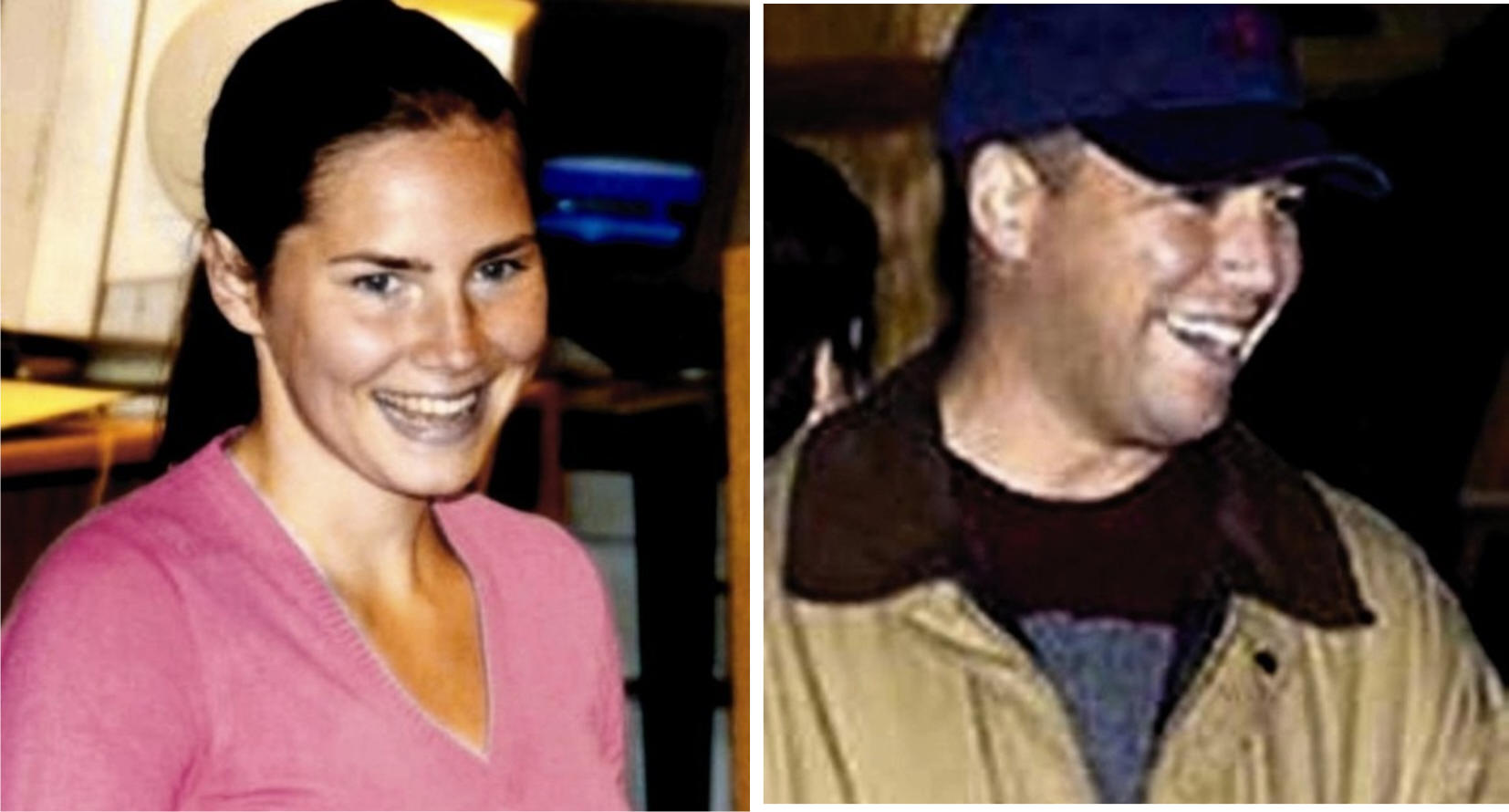
3. Reckless Odd Behavior And Lies By Amanda Knox
Amanda Knox had been cited and she had received a fine (a sentence which could have been more severe) for disturbing the peace and throwing rocks at a party in Seattle shortly before her departure to Italy.
Knox abruptly and without clear reason dropped a much-sought-after internship in Berlin, Germany, before arriving in Italy.
She posted a vignette on Facebook about a sexual liaison she had with a stranger, a middle-aged man, while on a train in Italy.
Her roommate Meredith had become increasingly disenchanted with the American flatmate who brought home different men without warning. “So she’s [Meredith] waking up in the morning and there’s someone making tea. And it’s, who are you again?” commented Meredith’s friend Brittany Murphy on the subject of Meredith’s unease at the strangers Knox brought to their rented Italian home.
Richard Owen, the Italy correspondent of the London Times in Italy, who has written multiple stories on the case, stated that Knox brought home “people who Meredith Kercher distrusted. Didn’t like the look of. It got to the point where she actually confronted Amanda about this.”
And Amanda Knox’s behavior after the Meredith’s murdered body was found in their rental home was more than atypical for someone who had their flatmate killed in such a horrific fashion in such close proximity.
- “As she put them on she swiveled her hips, pulled a face and said ‘hop la’ - I thought it was very unusual behavior and my suspicions against her were raised.” (Edgardo Giobbi, a police forensic scientist, testifying in court, describing Knox’s behavior just hours after the murder, after he handed Knox a pair of shoe-covers to prevent contaminating the evidence during a search of the house. Sky News, UK, May 30, 2009.)
- “While I was [at the police station] I found Amanda’s behavior very strange. She had no emotion while everyone else was upset. I remember one thing that really upset me. [Meredith’s friend] Natalie said, ‘I hope she wasn’t in too much pain.’ Amanda said, ‘What do you think? She fucking bled to death.’ At that point no one had told us how Meredith died.” (Robyn Butterworth, a friend of Kercher’s, testifying in court. London Evening Standard, Feb. 13, 2009.)
- “Their behavior at the police station seemed to me really inappropriate ... They sat opposite each other, Amanda put her feet up on Raffaele’s legs and made faces at him. Everyone cried except Amanda and Raffaele. I never saw them crying. They were kissing each other.” (Amy Frost, a friend of Meredith’s and a student at the University for Foreigners in Perugia at the time, testifying in court. The Independent, London, Feb. 14, 2009.)
- “My daughter was a Leeds student with Meredith in Perugia. They went out together on Halloween. When Amanda Knox was asked how she felt on 2 November, she said: “Shit happens”, which contrasts rather sharply with the contrived way she addressed the Italian court about “my friend Meredith”. (Marc Rivalland, in a letter to the editor of the Observer commenting on the Knox case. The Guardian, UK, 12/13/2009.)
- “They came into the shop at about 7 p.m. and were there for about 20 minutes. She bought a camisole and G-string. I heard her tell him that “˜Afterwards I’m going to take you home and put this on so we can have wild sex together.” (Store owner Carlo Maria Scotto di Rinaldi’s testimony in court about Knox and Sollecito’s behavior in his store, taped on closed-circuit TV.)
- “Knox and Sollecito were seen laughing as they hold up various G-strings. In one still shot taken from the footage, Raffaele is standing behind Amanda with his hands on her hips and his groin pressed into her. It was the same day as the candle light vigil memorial for Meredith, a few days after her murder.” (Excerpt from the book Angel Face by Barbie Nadeau.)
Perhaps the most controversial claim in the Knox trial was Knox’s accusation of Patrick Lumumba as the murderer of Meredith Kercher. Lumumba was placed under arrest and jailed for two weeks, until his solid alibi set him free.
Knox, who said nothing to help him during the two weeks Lumumba was incarcerated, changed her story after he was freed. She then claimed she was coerced by the police into making confusing statements. Knox’s entourage have made charges of human rights violations and anti-Americanism against the Italian justice system, though to date the U.S. government has refused to become involved.
- “He’s bad. He did it. He killed her”¦It was him, it was him, he was crazy, he killed her.” (Amanda Knox’s statements, according to police at the police station, accusing Patrick Lumumba of murdering Meredith Kercher. The Daily Telegraph, UK, March 6, March 21, 2009)
- “She was angry I was firing her and wanted revenge. By the end, she hated me. But I don’t even think she’s evil. To be evil you have to have a soul. Amanda doesn’t. She’s empty, dead inside. She’s the ultimate actress, able to switch her emotions on and off in an instant. I don’t believe a word she says. Everything that comes out of her mouth is a lie. But those lies have stained me forever.” (Patrick Lumumba, bar owner in Perugia and Knox’s boss. Daily Mail, UK, November 25, 2007)
4. Reckless Odd Behavior And Lies By Scott Petersen
Scott Peterson had all the appearances of an upwardly mobile middle-class white-collar worker. He was a salesman with a pretty wife and a baby on the way, and they owned a nice home in Modesto, California.
His friends and family described him as charismatic and friendly. But under the surface was a lifestyle filled with lies and mistresses.
Scott Peterson had hooked up with a mistress, Amber Frey, in November of 2002, leaving his pregnant wife home alone during the holiday season to see Amber Frey, with excuses of business meetings.
Peterson told Amber Frey that he was a widow, and also that he was traveling in France when he was actually in California - two of many false claims Peterson made to her.
- “I’m near the Eiffel Tower. The New Year’s celebration is unreal. The crowd is huge.” (Scott Peterson, from a taped telephone conversation to his mistress Amber Frey, telling her he is in Paris, when he is really in Modesto, California, about to attend a candle-light vigil for his missing wife. Dateline, NBC, 1/4/2005)
Shortly after Laci Peterson was reported missing, that candle light vigil was held for Laci. It was on New Year’s Eve.
- ”˜Three witnesses testified that Peterson’s behavior at the candle-light vigil seemed inappropriate for a worried husband. One woman said that he showed no emotion during the service and was grinning as he “socialized” with friends afterwards.’ (From The Murder of Laci Peterson, TrueTV.com)
The jurors were shown a photo of the grinning Peterson at the vigil at the trial as evidence. He called his mistress before and after the vigil ceremony, while Laci’s distraught family members tried to cope with the situation of their missing relative.
- “Scott came in with a great big smile on his face, laughing, it was just another day in paradise for Scott, another day that he had to go through the motions,” said one juror, Mike Belmessieri. “Scott had no emotion on his face. Scott was being Scott.” (Juror of the Scott Peterson Trial, commenting on his unusually cool demeanor in court. New York Times, March 17. 2005)
Shades of Amanda…
- “The cartwheels? This is Amanda just being Amanda. As her friends would say, it’s an Amanda thing.” (Edda Mellas, commenting on Knox turning cartwheels at the police station. The Guardian, UK, June 27. 2009)
- “I couldn’t help but think how cool and calm Amanda was. Meredith’s other friends were devastated and I was upset, but Amanda was as cool as anything and completely emotionless. Her eyes didn’t seem to show any sadness, and I remember wondering if she could have been involved.” (Giacomo Silenzi, Meredith’s Italian boyfriend who lived in the apartment downstairs from the murder. Metro.co.uk, November 18, 2007)
5. Parallels In Forensic Evidence
In both cases, there were no eye witnesses or “smoking gun.”
In Scott Peterson’s case, the ONLY piece of hard evidence was a single strand of Laci’s hair, found on pliers in Scott’s boat, which the defense charged as being contaminated evidence.
This and all rest of the evidence at his trial was circumstantial. Nobody witnessed any deed.
Both the circumstantial and forensic evidence in the Knox trial were more considerable. Key items of hard evidence included the knife found in Sollecito’s apartment that had Meredith’s DNA on the tip and Knox’s DNA on the handle, and it was accepted at trial as one of the murder weapons.
A bloody footprint, the size of Knox’s foot, was found on a pillow underneath Meredith’s body. Mixed DNA material of both Knox and Meredith were found in several spots in the house where the murder occurred.
6. Parallels In Strange Coincidences
Laci and Connor’s bodies were found in the water in the bay area of San Francisco. Scott Peterson happened to own a boat and liked to fish ““ in fact, he said he went fishing on Christmas Eve, the day Laci disappeared, at a location where later the bodies turned up only about 3 miles away.
Meredith was sexually molested, strangled, and ultimately killed by knife stabs. Raffaele Sollecito has a fascination with knives and he owns a large collection. Amanda Knox created and posted a fictitious story about a violent rape on the Internet.
Sollecito posted a photo of himself on the Internet swathed in bandages and holding a large meat cleaver and a jug of a chemical-looking liquid. Knox and Sollecito were the only ones at the house on the day when the police showed up and later discovered Meredith’s body.
The juries in both trials concluded that these factors were more than mere coincidences, and represented incriminating evidence of guilt of the crime.
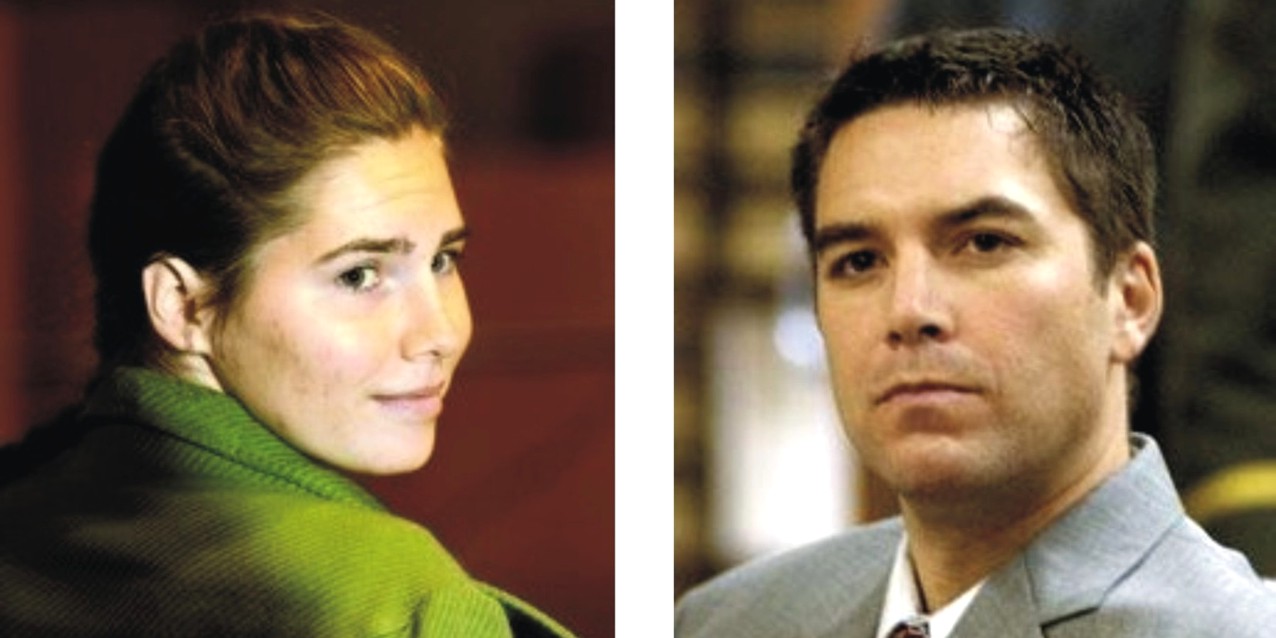
7. Parallels In How The Families Supported Their Children
Not all convicted murderers have a history of mental disturbance or violence. If there were any red flags regarding Knox’s and Peterson’s behavior, one would not know it from the descriptions provided by their families:
- ”˜Lee Peterson said his son never posed a discipline problem, did not rebel as a teenager and was a perfect baby. He was said even to lose golf games because he did not want to hurt the feelings of his opponents. ‘‘He woke up smiling and went to bed smiling.’’ (Scott Peterson’s father of his son, testifying to the jury after Scott’s guilty verdict but before sentencing. New York Times, December 2, 2004)
- “She was an incredible easy-going kid even from a baby. She was so mellow”¦She loved being read-to, she loved books. As she got a little older she always wanted to be outside - building camps, playing soccer. She never watched a lot of TV - she still doesn’t. She was an excellent student.” (Edda Mellas, commenting on Amanda Knox’s character the week of her guilty verdict. The Sun, UK, December 5, 2009)
8. Parallels In Family And Groupie Websites
Peterson and Knox’s families insist on their innocence. There are family and groupie websites for each convicted murderer. They each proclaim innocence for the guilty, make charges of police incompetence, and make requests for money for the defense cause and legal expenses:
- “Scott Peterson Family Mission Statement: “˜This web-site is a combined effort of our family and our support system. We know Scott is innocent and that he has been unjustly convicted. Our pursuit of justice for Laci, Conner and Scott remains steadfast. We want to keep you informed as to the specifics of the case, the appeal, and related topics. We also want you to know how grateful we are for your prayers and support.’ (From: http://scottpetersonappeal.org/)
- “Amanda Knox - A heartfelt thanks for your support. On behalf of Amanda and her family, we want to thank everyone who has contacted FOA to express their concern and to offer help in the wake of an unjust and unsupportable guilty verdict. We are developing a strategy to raise public awareness of this case and help bring about a reversal of the verdicts against both Amanda and Raffaele. Once it is in place, we will welcome all the help we can get, and we will be in touch with you.” (From http://www.friendsofamanda.org/home_eng.htmleartfelt)
Scott Peterson of course has never managed to get online. Amanda Knox of course runs a jubilant, taunting blog which trashes the memory of the victim and harasses her family - a first in global crime history and a foolish move given the current cold, remorseless rejection of her appeal.. Knox’s blog has a following among others also seemingly unable to succeed in normal ways.
9. Parallels In The Verdicts Jurors Delivered: Guilty As Charged
The jurors in each trial fitted together all the pieces of the puzzle: timelines, witness testimony, cell-phone records, forensic evidence, lack of solid alibis, incriminating lies, and odd behavior of the defendants.
They each concluded after lengthy deliberation that the defendants were guilty of murder.
10. And The NON-Parallels In How The US Media Has Reported Both Cases
Of these two cases, not many people have questioned the jury’s decision in the Scott Peterson trial. He has been sentenced to death via lethal injection, and he is currently incarcerated in San Quentin prison in California.
There are no repeated media interviews of Peterson’s mother in tears, insisting on his innocence and his release from prison. There are no angry declarations from Peterson family that the police, prosecution and legal system abused, railroaded and framed Scott Peterson.
If such media coverage were to exist, it would be widely considered in the US to be extremely upsetting and insulting to Laci’s parents and family and to the memory of the victims Laci and Connor.
Peterson’s media coverage, thankfully, has dissipated. He still pursues an appeals process, possibly to be heard next year by the California Supreme Court.
Amanda Knox’s story plays out very differently. After her arrest, her family hired a public relations team that puts forth a determined effort to change Knox’s image of wild child and murderer and to keep her in the news.
They obviously do not consider their repeated loud public outcries for release of their daughter distressing to Meredith’s parents and family, and they don’t perceive their actions as being disrespectful to the victim, Meredith.
Or of course, as many people suspect, perhaps Knox’s relatives do realize it but they simply don’t care.
11. Parallels In Future Legal Prospects
Imprisoned in Italy, Knox has been sentenced to 26 years in prison. She is now appealing that verdict and sentence for the second time after the first appeal was corrupted. In 2012 Scott Petersen’s lawyers filed the automatic appeal against his death sentence to which he is entitled by California law. He may end up serving life.
Knox’s prospects seemed considerably brighter than Peterson’s when the now-annulled Hellmann appeal of 2011 set her free. Now under the worst scenario she loses her new appeal and may end up serving life.
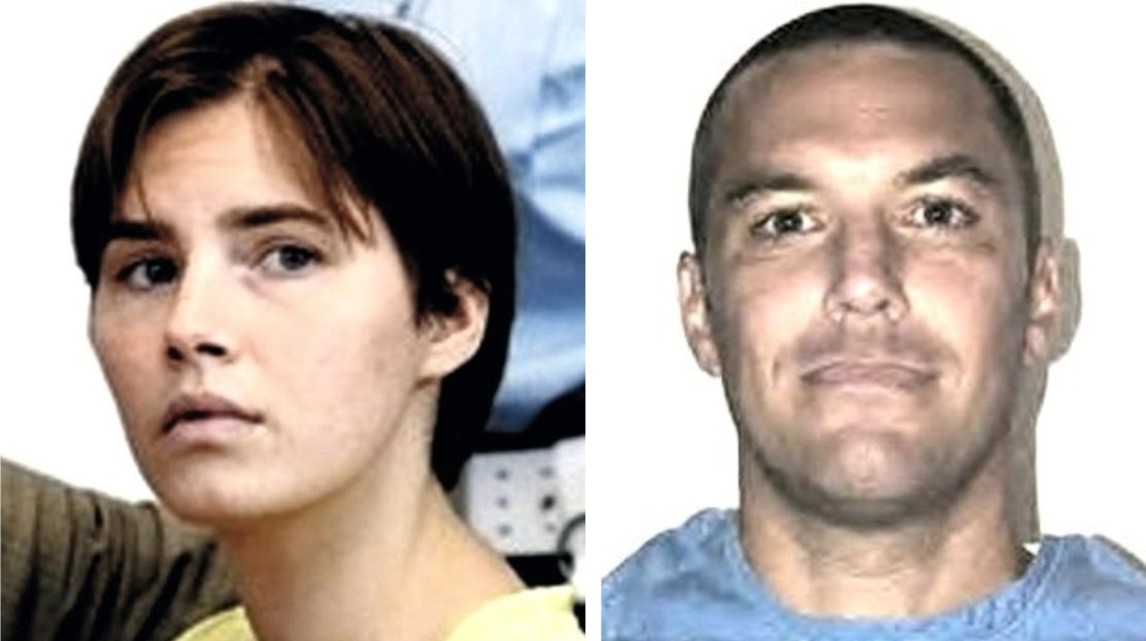
12. Epilogue ““ Master Manipulators
It is curious that the fervent supporters of Amanda Knox do not crusade for the release of Scott Peterson as well. After all, he was convicted on LESS direct evidence, and also in the midst of a maelstrom of publicity. CNN.com had called the Peterson prosecution case so weak and “unimpressive” that they speculated that he could end up with a “Not Guilty” verdict.
But with the exception of his own family, no one has picked up beating the drum to overturn the jury’s conviction of Peterson. Perhaps it is because Peterson doesn’t fit well the damsel in distress role? More likely, it is because the American public trusted the jury’s assessment of the evidence and trial, as they and the American media usually do, and they feel that the jury delivered a just verdict, and justice to Laci and Connor Peterson.
How is it possible that two “regular” people like Knox and Peterson ended up in jail for horrendous murders? Below is a condensed version from an AP article about the type of personality attributed to Scott Peterson:
It is interesting to note that life transitions are tremendous stresses to a psychopath. Psychopaths also wear “false faces” and are master manipulators. They are the ultimate con artists and they are able to fool even those closest to them.
Peterson’s closest friends “never suspected there was a monster inside Scott’s psyche.
Motive still a question in Peterson case
By the Associated Press
Tuesday, December 21, 2004
REDWOOD CITY, Calif. (AP)””Of all the questions surrounding the Laci Peterson murder case, the one that seemed to be running through practically everyone’s mind was this: If Scott Peterson was so unhappy in his marriage, why didn’t he just get a divorce?Experts on the criminal mind say the answer may lie in what lurked beneath Scott Peterson’s charming veneer “”a psychopathic personality.
“When you say you’re going to get a divorce, everyone knows that it’s a long, tedious process. The psychopath wants the short-term solution,” said San Diego forensic psychologist Reid Meloy.
Peterson, 32, was convicted earlier this month of murdering his eight-months-pregnant wife and the fetus she was carrying, and the jury decided he deserves the death penalty.
Criminal psychologists say Peterson appeared to be a master manipulator who lacked the capacity to feel remorse or consider consequences “”some of the same psychopathic characteristics exhibited by serial killers Ted Bundy and John Wayne Gacy.
Psychopaths “tend to con people very well and they wear false faces,” said former FBI profiler Robert Ressler. “They tend to be able to fool everyone from their families to their friends to society, schools, their community.”
At Peterson’s trial, prosecutors portrayed him as a callous liar who continued to carry on an extramarital affair even as police searched for his wife. They said he killed her to escape marriage and impending fatherhood for the freewheeling single life.
Whether Laci’s pregnancy was the catalyst for Peterson’s plan may never be known. But experts said pregnancy can lead to seismic changes within a relationship.
Pregnancy “represents commitment, fatherhood, another dependent, a lifelong bond ... and all of those things are strongly despised by the psychopath,” Meloy said”¦ pregnancy represents a life transition, and there are stresses around that transition.”
Peterson’s case was made all the more perplexing by the lack of signs that the couple’s marriage was in trouble. Although Peterson had cheated on Laci at least three times, according to defense attorney Mark Geragos, he appeared to family and friends to be a doting husband and father-to-be after Laci became pregnant.
Those closest to the couple said they never suspected there was a monster inside.
Heather Richardson, the maid of honor at the Petersons’ wedding, is still hoping for a plausible explanation to emerge. Perhaps, she said, Peterson suffers from a disorder that has yet to be revealed.
“It would be at least comforting. Then I would realize that the person I knew and loved dearly was there. He was that person and the other person, too,” Richardson said. “So at least part of him was not a lie.”
Here is Amanda Knox in her own words talking about masks “” while taking the stand for the final time at her trial in Italy (CNN, Dec. 3, 2009): “They say that I am calm. I am not calm ... I fear to lose myself, to have the mask of the assassin forced upon me.”
This is an update of my post of 24 July 2010
Wednesday, December 18, 2013
Demonizations By Knox: Multiple Ways In Which Her Email To Judge Nencini Is Misleading
Posted by FinnMacCool
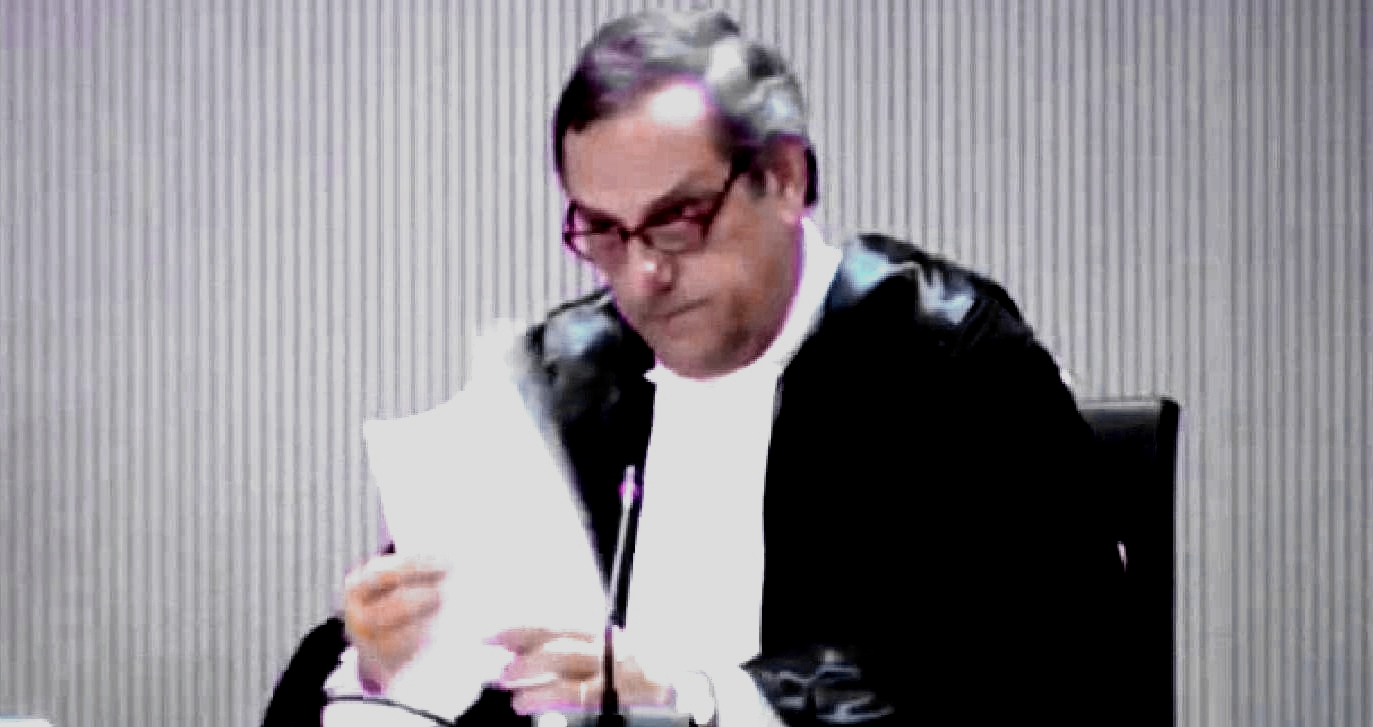
You can read here the email Amanda Knox sent to Judge Nencini.
It is dated 15 December 2013 and was handed to Dr Nencini by Dr Ghirga, apparently to the disdain of both of them. It contains many statements which, if she were under oath, could be considered perjury.
One telling point is that she claims “I am not present in the courtroom because I am afraid.” Her co-defendant, Raffaele Sollecito, was not at all afraid of being at their own appeal, and he did present himself at an earlier stage of the proceedings.
He made a spontaneous statement and the judge assured him that he should feel free to intervene to make further interventions whenever he wished. So far he hasn’t wished to - he preferred to head back to the Caribbean for his holiday.
But that event and that presence by Sollecito completely undermine the credibility of Knox’s claim that she feels afraid of the court proceedings. As it is her own appeal, there would be nothing to stop her coming and going, at any stage, just as Sollecito did.
I have no doubt that my lawyers have explained and demonstrated the important facts of this case that prove my innocence and discredit the unjustified accusations of the prosecution and civil parties.
That’s what her lawyers were about to try to do. But instead they had to hand this email to the judge, showing their client’s complete contempt for the court process.
I seek not to supplant their work
She doesn’t want to supplant the work of her own lawyers? Most defendants don’t, nor do they feel the need to tell the court that using an archaic seventeenth-century grammatical construction (where modern English would have “I do not mean to…” or “I do not wish to”).
Because I am not present to take part in [my own appeal], I feel compelled to share.
As Judge Nencini said, if anyone wants to talk to a court, come to that court. Knox chose not to be present, which means that the word “because” is not a logical connector for why she feels compelled to share what she thinks. “Even though” would make more sense.
The Court has access to my previous declarations and I trust will review them…
The court has access to thousands of pages. Everybody trusts that courts will review the evidence before passing judgment - that’s how the legal process works.
I must repeat: I am innocent.
In fact, she does not have to repeat that, which is simply a reiteration of her not-guilty plea.
I am not present in the courtroom because I am afraid.
The wording is reminiscent of a previous declaration, “I am very afraid of Patrik, the African boy who…” Also the court may remember the presence of her co-defendant, who made a brief presentation to the court (and was invited to intervene again at any time he saw fit) and who afterwards flew back to his extended vacation in the Dominican Republic. It is difficult to see what the defendants have to be afraid of from the court - except perhaps the truth.
I am afraid that the prosecution’s vehemence will leave an impression on you, that their smoke and mirrors will blind you.
The prosecution’s case has already been made; this was the opportunity for the defense to make their case. It is the court’s duty to consider the evidence without being overly swayed by the vehemence of lawyers from either side - they look at the facts, and pass judgment based on that, and this happens in literally millions of cases every year. (Cassazione alone reviews more than 80 thousand cases each year.)
This is not for lack of faith in your powers of discernment, but because the prosecution has succeeded before in convincing a perfectly sound court of concerned and discerning adults to convict innocent people - Raffaele and me.
The second half of the sentence contradicts the first. The writer is explicitly stating that she doubts that the court has sufficient powers of discernment to be able to see through the prosecution’s arguments. Her justification for saying this is simply that it has happened before, with a previous court.
I’ve attentively followed this process and gleaned the following facts…
This is a delusional statement. The writer is the appellant, the initiator of the process, not an external observer to it. We can compare it with her statements following her arrest, in which she claimed still to be helping the police on an equal basis with them, despite being charged with the murder.
No physical evidence places me in Meredith’s bedroom, the scene of the crime…
The bedroom is where the murder took place, but the crime scene is much wider than that, and certainly encompasses the adjoining room where the burglary was faked, the bathroom where the killers cleaned up, and the corridor that connects those rooms. Knox’s blood, DNA, bare footprints are all found in those places. Within Meredith’s room itself, there is also a woman’s shoeprint that does not match the victim, and which Knox’s own lawyer was obliged to claim was caused by an unfortunate fold in the pillowcase.
Meredith’s murderer left ample evidence in the brutal scenario: handprints, footprints, shoe prints in Meredith’s blood, DNA in her purse, on her clothing, in her body.
The term “brutal scenario” makes no sense here, although she repeats it again a couple of lines later. Perhaps she means “crime scene” or “bedroom”. The only footprints found at the crime scene are those of Knox and Sollecito. A woman’s shoeprint in the room where the murder took place cannot be that of either Guede or the victim, and is most likely that of Knox.
The prosecution has failed to explain how I could have… been the one to fatally wound Meredith ““ without leaving any genetic trace of myself. That is because it is impossible.
Actually it is perfectly possible to do this ““ for example, simply by stabbing someone to death while wearing gloves. However, in this case the prosecution has in fact explained how several traces of Knox’s DNA have been found on the handle of the knife which had the victim’s DNA on the blade. That obviously fits a scenario in which Knox stabbed Meredith Kercher with that knife.
Either I was there, or I wasn’t.
The same thing applies to the appeal court. Either the defendants are there, or they are not. In this case, the defendant is not.
The analysis of the crime scene answers this question: I wasn’t there.
Knox’s footprints, blood and DNA, sometimes mixed with that of the victim, all place her at the crime scene, and so does her DNA on the handle of the murder weapon.
My interrogation was illegal and produced a false “confession” that demonstrated my non-knowledge of the crime.
“Non-knowledge” is a curious word. Knox’s witness interview was perfectly legal ““ it was only the unexpected confession from the witness that changed the status of that interview, so that its contents could no longer be used against her. But there is no question over its legality.
The subsequent memoriali, for which I was wrongfully found guilty of slander…
This is an extraordinary aside. The defendant is here rejecting the legitimacy of the Italian Supreme Court, which has definitively found against her, and is also rejecting the findings of the Hellmann court that provisionally freed her, pending appeal. Every single court has found against her on this count.
. ...did not further accuse but rather recanted that false “confession”.
Let us reread some excerpts from this supposed recantation: “After dinner I noticed there was blood on Raffaele’s hand… I stand by my statements that I made last night about events that could have taken place in my home with Patrik… In these flashbacks I’m having, I see Patrik as the murderer…Why did I think of Patrik?... Is there any other evidence condemning Patrik or any other person?” This is not a recantation, and it does in fact contain further accusations of Patrick Lumumba while also seeking to throw suspicion both on Sollecito and an unnamed “other person”.
My behavior after the discovery of the murder indicates my innocence.
As dozens of witnesses have testified in a series of trials and appeals, Knox’s post-murder behavior indicated the exact opposite, which is why suspicion fell on her in the first place.
I did not flee Italy when I had the chance.
On page 71 of her memoir, Knox recounts the following exchange with Officer Ficarra, on the day after the murder was discovered: “My parents want me to go to Germany to stay with relatives for a couple of weeks. Is that okay?” She said, “You can’t leave Perugia. You’re an important part of the investigation.”
I stayed in Perugia and was at the police’s beck and call for over 50 hours in four days.
Chapter Ten of her memoir gives her own account of what she did on Monday, November 5th. She went to a nine o’clock grammar class, at which she refused to discuss the case with her fellow students; she spoke on the phone with her Aunt Dolly, admitting that she had not yet contacted the US embassy; she bumped into Patrick Lumumba where she refused to talk to BBC reporters; she spent the afternoon with Sollecito and then accompanied him to a friend’s house where she played the ukulele. Far from being at the police’s beck and call, she ignored their request that she stay home while they interview Sollecito separately, and turned up to the Questura regardless, although not before they had finished their evening meal.
The police coerced me into signing a false “confession””¦.
Her false accusation of Patrick Lumumba, for which she was convicted and has already served four years in prison, was not a confession and was not coerced.
. “¦one may be coerced into giving a false “confession” because of psychological torture”¦ This is a universal problem.
The US-based Innocence Project reports that there have been 244 exonerations since 2000, which is just over seventeen per year, which in turn means that currently in the USA, roughly 0.1% of cases are eventually overturned. Being wrongfully convicted might be devastating for the person concerned, but it is not a universal problem.
I did not carry around Raffaele’s kitchen knife.
The defendant has not been accused of carrying the knife around, but rather of stabbing Meredith Kercher to death with it. Forensic evidence supports that accusation, too.
I had no contact with Rudy Guede. Like many youth in Perugia, I had once crossed paths with Rudy Guede.
Very typical of Knox’s writing is this kind of self-contradiction, sometimes occurring within the same sentence, or as in this case, in consecutive sentences, seemingly with no self-awareness that any contradiction has even occurred.
If the prosecution truly had a case against me, there would be no need for these theatrics.
The prosecution is present in the court, having made its presentation in the usual way. The defense lawyers are about to do exactly the same thing. The only theatrics happening in the court at that moment is a bizarre email sent by one of the defendants, in lieu of attending her own appeal to her own murder conviction.
But because no evidence exists that proves my guilt, the prosecution would seek to deceive you with these impassioned, but completely inaccurate and unjustified pronouncements.
No further comments.
Tuesday, December 17, 2013
Appeal Session #7: The Day For Knox And Sollecito Attorneys To Show Where Prosecution Went Wrong
Posted by Our Main Posters
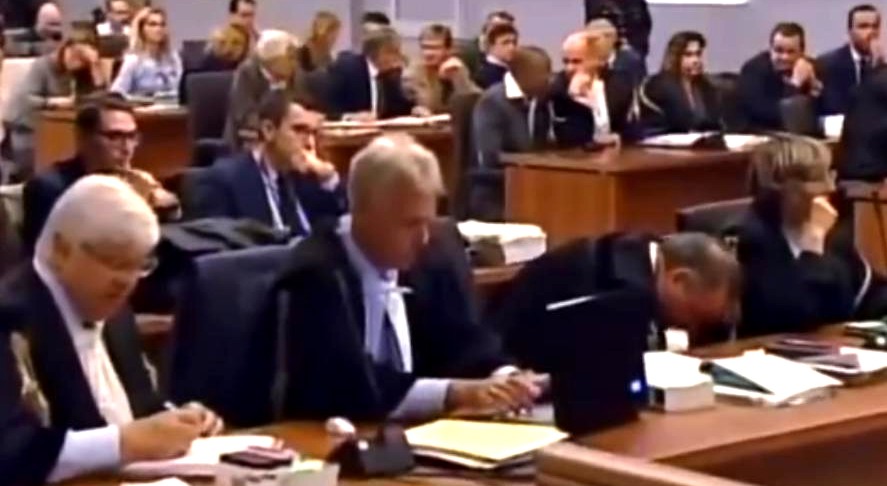
[Above and below: images from previous sessions, here till today’s crop appears]
Long Form Reports
The court hearing reserved for Knox’s appeal defense began with the reading of an email from Amanda, reported here in the Messaggero and then widely picked up in the English-language press, claiming her innocence and explaining why she was afraid to return to Italy. The email was the only “new” aspect introduced Tuesday so made all the headlines, but at the end of the day it occupied just a small fraction of the day’s arguments.
Several Italian court observers considered the email a considerable “own goal,” having witnessed the presiding judge raise his eyebrows in obvious annoyance at having to himself read aloud an email from Knox, who requested an appeal in his courtroom, but is refusing to attend it, for reasons she detailed. “Those who want to speak at the trial should come to the trial,” he said. He also declined to consider the letter a spontaneous declaration because, he said, he could not ascertain if she was the true author of the letter. “I’ve never seen her. I do not know her,” he said.
After the email, Knox’s Perugian lawyer Luciano Ghirga made his closing arguments, followed by Carlo Dalla Vedova of Rome. Most of the discussion focused on two aspects of the case they felt are fundamentally lacking: motive and murder weapon. Below are short quotes/snippets translated quickly during court. To read the Kercher family lawyer’s arguments, scroll down to yesterday’s notes.
[Report continues on The Freelance Desk with good summaries of arguments made by Ghirga and Della Vedova]
3. Tweets from La Nazione
66. Meredith process , the hearing ends. The next hearing will be on January 9 [Sollecito team]
65. Lawyer Dalla Vedova (Knox) : ” Amanda Knox is shown to have worshipped [Meredith]”
64. Lawyer Dalla Vedova (Knox) : “There is a shortage of proof”
63. Lawyer Dalla Vedova (Knox) : “There is no evidence, with doubts you have to acquit Amanda Knox”
62. Lawyer Dalla Vedova (Knox) : “On the motive the prosecutor did the same as the Costa Concordia at Giglio”
61. Lawyer Dalla Vedova (Knox) : “Room too small for the participation of more people in the crime”
60. Lawyer Dalla Vedova (Knox) : “The victim was attacked from the front, not from behind”
59. Lawyer Dalla Vedova (Knox) : “For Amanda and Raffaele, Rudy Guede was a stranger”
58. Lawyer Dalla Vedova (Knox) : “The bra clasp of Meredith is not a genuine artifact”
57. Lawyer Dalla Vedova (Knox) : “The bra clasp November 2nd was white, but 40 days after gray”
56. Lawyer Dalla Vedova (Knox) : “Amanda knew the cut was throat because she was told by a policeman “
55. Lawyer Dalla Vedova (Knox) : “Absurd that there are missing only traces of Amanda and Raffaele “
54.Lawyer Dalla Vedova (Knox) : “The alleged footprint of female shoe on the pillow: pillowcase was folded over.”
53. Lawyer Dalla Vedova (Knox) : “The broken glass from the window shows the easiest way to enter the house “
52. Lawyer Dalla Vedova (Knox) : “War between consultants is like “The War of the Roses” where everyone will hate “
51. Lawyer Dalla Vedova (Knox) : “Unable for Amanda and Raffaele to commit the crime in 50 minutes “
50. Lawyer Dalla Vedova (Knox) : “The mother of Meredith says she and Amanda were friends “
49. Lawyer Dalla Vedova (Knox) : “Guede never says that Amanda was in the house, even outside the interrogations”
48. Lawyer Dalla Vedova (Knox) : “Guede never talks about Amanda “
47.Lawyer Dalla Vedova (Knox) : ” Guede in his chats after the murder told a friend that Amanda had nothing to do with it”
46. Lawyer Dalla Vedova (Knox) : “There are traces only of Rudy Guede at the crime scene “
45. Lawyer Dalla Vedova (Knox) : “The witness Curatolo either is unreliable or is our alibi. Decide for yourself “
44. Lawyer Dalla Vedova (Knox) : “Do not trust the testimony of the witness Quintavalle “
43. Lawyer Dalla Vedova (Knox): “Amanda did not call into question Lumumba to sidetrack the investigation “
42. Lawyer Dalla Vedova (Knox): “The alibi of Amanda is of the same type as her roommates ”
41. Lawyer Dalla Vedova (Knox): “The alibi of Amanda is accurate and unchanged in her deposition ”
40. Meredith appeal: the argument of Carlo Dalla Vedova, defender of Amanda Knox, resumes.
39. Meredith appeal: Judge orders one-hour lunch break
38. President Nencini asks if there are certificates for the AIDS tests done on Amanda, but there are none
37. Lawyer Dalla Vedova (Knox): “It was said of Amanda in prison that she had AIDS, but it turned out an error ”
36. Lawyer Dalla Vedova (Knox): “From the conversations in prison Amanda does not show anything, the sum of zeros ”
35. Lawyer Dalla Vedova (Knox): “In 30 hours of interviews with parents in prison Amanda never was heard [incriminating herself]”
34. Lawyer Dalla Vedova (Knox): “It was immediately admited, the mistake by the investigators”
33. Lawyer Dalla Vedova (Knox): “The footprint of Guede on the pillow right now is the signature of the crime”
32. Lawyer Dalla Vedova (Knox): “Lumumba was not to be charged, he confirmed his alibi”.
31. Lawyer Dalla Vedova (Knox): “There has been judicial harassment against [my client]”
30. Lawyer Dalla Vedova (Knox): “Prosecution and plaintiff leverage statements of Amanda unusable ”
29. Lawyer Dalla Vedova (Knox): “The declarations of Amanda between 5 and 6 November are unusable ”
28. Lawyer Dalla Vedova (Knox): “Absurd that Amanda is joining the attack on a friend ”
27. Lawyer Dalla Vedova (Knox): “Changing motive is constantly an element of weakness of the prosecution ”
26. Lawyer Dalla Vedova: “Add up all the clues , the sum of zero is always zero ”
25. Lawyer Dalla Vedova: “Without connections between clues and evidences the value is zero ”
24. Lawyer Dalla Vedova: “In this process there is no evidence ”
23. Lawyer Dalla Vedova: “A murder without a motive is fallacious ”
22. Lawyer Dalla Vedova: “Absurd that the knife used for the murder was brought home ”
21. Lawyer Dalla Vedova: “Imaginative reconstruction of the prosecution ”
20. Lawyer Dalla Vedova: “This story has been in the headlines for months ”
19. Lawyer Dalla Vedova (Knox): “Meredith killed in this manner is a defeat for all ”
18. The closing argument of Lawyer Carlo Dalla Vedova begins (Knox defense).
17. Meredith appeal: the closing argument of the Lawyer Ghirga (Knox ) ends.
16. Lawyer Ghirga (Knox ) : “Amanda Knox was not present at the crime scene ”
15. Lawyer Ghirga (Knox ): “The judgment of Justice is the acquittal of Amanda
14. Lawyer Ghirga (Knox ): “The witness Curatolo is unreliable ”
13. Lawyer Ghirga (Knox ): “We challenged from the outset the murder weapon ”
12. Lawyer Ghirga (Knox ): “On the blade of the knife there is no blood and no trace of Meredith.”
11. Lawyer Ghirga (Knox ): “The expertise that revealed traces of Meredith on the knife is not trusted “
10. Lawyer Ghirga (Knox ): “The knife found at Sollecito’s house is not the murder weapon “
9. The closing argument of Luciano Ghirga defender Amanda Knox begins.
8. Amanda to the court: ” I am innocent , put an end to this enormous injustice ”
7. Amanda : “I’m not the monster he has been portrayed in recent years ”
6. Amanda: ” I did not know Rudy Guede ”
5. Amanda: “I’m not a killer , the prosecution and the civil parties are wrong , they want a conviction without proof ”
4. Amanda: ” Meredith and I have always been friends , we never quarreled ”
3. Amanda: “I have been subjected to illegal interrogation , I made a false confession extorted”
2. Amanda: “I have not killed , raped , robbed , I was not at the scene of the crime”
1. The email of Amanda : “I’m innocent , but I am not in court because I’m afraid”
2. Tweets from Freelance Andrea Vogt
3. Carlo dalla Vedova to #amandaknox appeal jury: If there is no murder motive, you must acquit.
2. Carlo dalla Vedova: We know #amandaknox is innocent. As time passes we’re even more tranquil.There are many more doubts than certainties.
1. In Florence, amanda knox lawyer holds up large knife to jury: “Starch was on the knife. It was not cleaned. It was in domestic use.”
1. Email from Amanda Knox
Court of Appeals of Florence section II Assise Proc. Pen, 11113
Letter sent to attorneys Carlo Dalla Vedova and Luciano Ghirga via email Seattle, 15 December 2013
Attn: Honorable Court of Appeals of Florence
I have no doubt that my lawyers have explained and demonstrated the important facts of this case that prove my innocence and discredit the unjustified accusations of the prosecution and civil parties. I seek not to supplant their work; rather, because I am not present to take part in this current phase of the judicial process, I feel compelled to share my own perspective as a six—year-long defendant and victim of injustice.
The Court has access to my previous declarations and I trust will review them before coming to a verdict. I must repeat: I am innocent.
I am not a murderer. I am not a rapist. I am not a thief or a plotter or an instigator. I did not kill Meredith or take part in her murder or have any prior or special knowledge of what occurred that night. I was not there and had nothing to do with it.
I am not present in the courtroom because I am afraid. I am afraid that the prosecution’s vehemence will leave an impression on you, that their smoke and mirrors will blind you. I’m afraid of the universal problem of wrongful conviction. This is not for lack of faith in your powers of discernment, but because the prosecution has succeeded before in convincing a perfectly sound court of concerned and discerning adults to convict innocent people-Rafael and me.
My life being on the line and having with others already suffered too much, I’ve attentively followed this process and gleaned the following facts that have emerged from the development of this case that I beg you not to dismiss when making your judgment:
No physical evidence places me in Meredith ‘s bedroom, the scene of the crime, because I was not there and didn’t take part in the crime.
Meredith’s murderer left ample evidence of his presence in the brutal scenario: handprints, footprints, shoe prints in Meredith’s blood; DNA in her purse, on her clothing, in her body.
No evidence places me in the same brutal scenario. The prosecution has failed to explain how I could have participated in the aggression and murder—to have been the one to fatally wound Meredith—without leaving any genetic trace of myself. That is because it is impossible. It is impossible to identify and destroy all genetic traces of myself in a crime
scene and retain all genetic traces of another individual. Either I was there, or I wasn’t. The analysis of the crime scene answers this question: I wasn’t there.
My interrogation was illegal and produced a false “confession” that demonstrated my non-knowledge of the crime- The subsequent memoriali, for which I was wrongfully found guilty of slander, did not further accuse but rather recanted that false “confession.” Just as I testified to the prosecutor in prison and to my family members in prison when our conversations were being recorded without my knowledge.
My behavior after the discovery of the murder indicates my innocence. I did not flee Italy when I had the chance. I stayed in Perugia and was at the police’s beck and call for over 50hours in four days, convinced that I could help them find the murderer. I never thought or imagined that they would have used my openness and trust to fuel their suspicions. I did not hide myself or my feelings: when I needed comfort, Rafael embraced me; when I was sad and scared, I cried; when I was angry, I swore and made insensitive remarks; when I was shocked, I paced or sat in silence; when I was trying to help, I answered questions, consoled Meredith’s friends and tried to keep a positive attitude.
Upon entering the questura I had no understanding of my legal position. Twenty—years old and alone in a foreign country, I was innocent and never expected to be suspected and subjugated to torture. I was interrogated as a suspect, but told I was a witness. I was questioned for a prolonged period in the middle of the night and in Italian, a language I barely knew. I was denied legal counsel- The Court of Cassation deemed the interrogation and the statements produced from it illegal. I was lied to, yelled at, threatened, slapped twice on the back of the head. I was told I had witnessed the murder and was suffering from amnesia. I was told that if I didn’t succeed in remembering what happened to Meredith that night I would never see my family again. I was browbeaten into confusion and despair. When you berate, intimidate, lie to, threaten, confuse, and coerce someone in believing they are wrong, you are not going to find the truth.
The police coerced me into signing a false “confession” that was without sense and should never have been considered a legitimate investigative lead. In this fragmentary and confused statement the police identified Patrick Lumumba as the murderer because we had exchanged text messages, the meaning of which the police wrongfully interpreted (‘Civediamo piu tardi. Buona serata’). The statement lacked a clear sequence of events, corroboration with any physical evidence, and fundamental information like: how and why the murder took place, if anyone else was present or involved, what happened afterward—it supplied partial, contradictory information and as the investigators would discover a little later, when Patrick Lumumba’s defense lawyer produced proof of him incontestable alibi, it was obviously inaccurate and unreliable. I simply didn’t know what they were demanding me to know. After over 50 hours of questioning over four days, I was mentally exhausted and I was confused.
This coerced and illegitimate statement was used by the police to arrest and detain a clearly innocent man with an iron-clad alibi with whom I had a friendly professional relationship. This coerced and illegitimate statement was used to convict me of slander. The prosecution and civil parties would have you believe that this coerced and illegitimate statement is proof of my involvement in the murder. They are accusing and blaming me, a result of their own overreaching.
Experience, case studies, and the law recognize that one may be coerced into giving a false"confession” because of torture.
This is a universal problem. According to the National Registry of Exoneration, in the United States 78% of wrongful murder convictions that are eventually overturned because of exonerating forensic evidence involved false “confessions.” Almost 8 in 10 wrongfully convicted persons were coerced by police into implicating themselves and others in murder. I am not alone. And exonerating forensic evidence is often as simple as no trace of the wrongfully convicted person at the scene of the crime, but rather the genetic and forensic traces of a different guilty party—just like every piece of forensic evidence identifies not me, but Rudy Guide.
In the brief time Meredith and I were roommates and friends we never fought.
Meredith was my friend. She was kind to me, helpful, generous, fun. She never criticized me. She never gave me so much as a dirty look.
But the prosecution claims that a rift was created between Meredith and I because of cleanliness. This is a distortion of the facts. Please refer to the testimonies of my housemaster and Meredith’s British friends. None of them ever witnessed or heard about Meredith and I fighting, arguing, disliking each other. None of them ever claimed Meredith was a confrontational clean-freak, or I a confrontational slob. Laura Masotho testified that both Meredith and I only occasionally cleaned, whereas she and Filomena Romanelli were more concerned with cleanliness. Meredith’s British friends testified that Meredith had once told them that she felt a little uncomfortable about finding the right words to kindly talk tome, her new roommate, about cleanliness in the bathroom we shared. The prosecution would have you believe this is motivation for murder. But this is a terrifying distortion of the facts.
I did not carry around Rafael’s kitchen knife.This claim by the prosecution, crucial to their theory, is uncorroborated by any physical evidence or witness testimony. I didn’t fear the streets of Perugia and didn’t need to carry around with me a large, cumbersome weapon which would have ripped my cloth book bag to shreds. My book bag showed no signs of having carried a bloody weapon. The claim that he would have insisted I carry a large chef’s knife is not just senseless, but a disturbing indication of how willing the prosecution is to defy objectivity and reason in order to sustain a mistaken and disproven theory.
It is yet another piece of invented “evidence”, another circumstance of theory fabricated to order, because having discovered nothing else, the prosecution could only invent.
I had no Contact with Rudy Guide.
Like many youth in Perugia, I had once crossed paths with Rudy Guide. He played basketball with the young men who lived in the apartment below us. Meredith and I had been introduced to him together. Perhaps I had seen him amongst the swarms of students
who crowded the Perugian streets and pubs in the evenings, but that was it. We didn’t have each other’s phone number, we didn’t meet in private, we weren’t acquaintances. I never bought drugs from Rudy Guide or anyone else. The phone records show no connection. There are no witnesses who place us together. The prosecution claims I convinced Rudy Guide to commit rape and murder, completely ignoring the fact that we didn’t even speak the same language. Once again, the prosecution is relying upon a disturbing and unacceptable pattern of distortion of the objective evidence.
I am not a psychopath.
There is no short list to the malicious and unfounded slanders I have suffered over the course of this legal process. In trial I have been called no less than:
“Conniving; manipulating; man—eater; narcissist; enchantress; duplicitous; adulterer; drug addict; an explosive mix of drugs, sex, and alcohol; dirty; witch; murderer; slanderer; demon; depraved; imposter; promiscuous; succubus; evil; dead inside; pervert; dissolute; a wolf in sheep’s clothing; rapist; thief; reeking of sex; Judas; she-devil;
I have never demonstrated anti-social, aggressive, violent, or behavior. I am not addicted to sex or drugs. Upon my arrest I was tested for drugs and the results were negative. I am not a split-personality One does not adopt behavior spontaneously.
This is a fantasy. This is uncorroborated by any objective evidence or testimony. The prosecution and civil parties created and pursued this character assassination because they have nothing else to show you. They have neither proof, nor logic, nor the facts on their side. They only have their slanders against me, their personal opinions about me. They want you to think I’m a monster because it is easy to condemn a monster. It is easy to dismiss a monster’s defense as deception. But the prosecution and civil parties are both severely mistaken and wrong. They have condemned me without proof of guilt, and they seek to convince you to condemn me without proof of guilt.
If the prosecution truly had a case against me, there would be no need for these theatrics. There would be no need for smoke and mirrors to distract you from the lack of physical evidence against me. But because no evidence exists that proves my guilt, the prosecution would seek to deceive you with these impassioned, but completely inaccurate and unjustified pronouncements. Because I am not a murderer, they would seek to mislead you into convicting me by charging your emotions, by painting me not as an innocent until proven guilty, but as a monster.
The prosecution and civil parties are committing injustices against me because they cannot bring themselves to admit, even to themselves, that they’ve made a terrible mistake.
The Court has seen that the prosecution and civil parties will not hear criticism of their mistakes. Not by the experts of the defense, nor by the experts of the Court.
The Court has seen that the prosecution jumped to conclusions at the very start of their investigation: they interrogated and arrested innocent people and claimed “Case Closed"before any evidence could be analyzed, before bothering to check alibis.
The prosecutor and investigators were under tremendous pressure to solve the mystery of what happened to Meredith as soon as possible. The local and International media was breathing down the necks of these detectives. Their reputations and careers were to be made or broken. In their haste, they made mistakes. Under pressure, they admitted to as few mistakes as possible and committed themselves to a theory founded upon mistakes.
Had they not jumped to conclusions based on nothing but their personal and highly subjective feeling, they would have discovered definitive and undeniable evidence of not Patrick Lumumba, not Rafael Sollecito, not Amanda Knox, but of Rudy Guide. We would not be here over six years later debating inconclusive and unreliable “clues.” We would have been spared the cost, anguish and suffering, not only of Raffaele’s and my family, but especially of Meredith’s family as well.
The prosecution’s accusations are unworthy of judicial or public confidence. In over six years they have failed to provide a consistent, evidence-driven, corroborated theory of the crime, but would nevertheless argue that you should take my life away. I beg you to see the facts and reason of what I say. I am innocent. Rafael is innocent. Meredith and her family deserve the truth. Please put an end to this great and prolonged injustice.
in faith,
Amanda Marie Knox
Monday, December 16, 2013
Appeal Session #6: Case For Knox’s & Sollecito’s Guilt - The Civil Parties
Posted by Our Main Posters
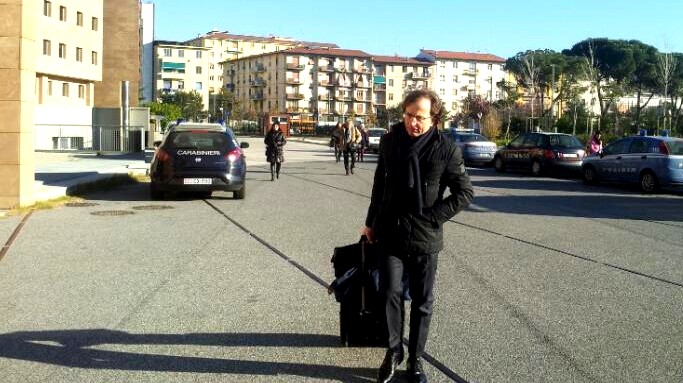
[Above, today: Dr Maresca, the Florence lawyer who speaks for the victim, arrives at the court]
7. Court resumes tomorrow
Court will resume at 9:30 am Italy time with the first of the summations for the defenses. When they conclude, probably in January, the prosecution will have a chance of rebuttal.
6. Reporting in English
Andrea Vogt has posted a detailed report from the court at The Freelance Desk, Scroll down to the heading “Update Dec 1t 2013”
5. Reporting in Italian #3
Amanda Knox and Raffaele Sollecito, accused in the murder of British student Meredith Kercher, were in the grip of a “murderous rage” fuelled by illegal drugs and alcohol, a lawyer for the victim’s family said Monday. Knox, Sollecito and a third person definitively convicted of the crime, Rudy Guede, had “no inhibitions” because of the drugs and alcohol they ingested before murdering Kercher in November 2007, charged Vieri Fabiani.
Only later did the “fear take over” and led to false explanations including a simulated break-in and robbery, and a false accusation against a bar owner in Perugia, where the murder occurred, added Fabiani. A Florence court is trying the case against Knox and Sollecito, who have been on trial twice before for the murder of Kercher. Both have said they are not guilty of the accusations.
Guede was convicted in a fast-track trial and is serving a 16-year sentence in the murder, but Italy’s top appeal court said it was unlikely he acted alone. Knox, who is in the United States and has not returned for this trial, and Sollecito each served two years in prison after a lower court convicted them of murder in 2009. An appeal court overturned those convictions in 2011 and in March, Italy’s highest court sent the case back to the appeals stage over aspects of the evidence it argued had not been properly examined before.
The supreme court ruled that the initial forensic evidence had been wrongly dismissed in the acquittal and a prosecution theory about a sex game that went wrong should be re-examined. Kercher, 21, was found dead on the floor of an apartment she shared with Knox on November 2, 2007. Guede’s DNA was found inside Kercher, on her clothes, and elsewhere in the apartment.
Fabiani said that a motive for the murder was “irrelevant” because the crime was committed while the trio were abusing substances. An Italian prosecutor has requested a 26-year prison term for Knox and Sollecito for the murder, plus a further four years for Knox for allegedly slandering bar owner Patrick Lumumba, whom she initially implicated during tough police questioning before later retracting, saying she had been confused.
The new trial opened in Florence in September, and a decision is expected on January 10.
Translation by The 411
4. Reporting in Italian #2
For the Kercher family it is “intolerable” that Amanda Knox on her website is issuing “invitations to collect donations in memory of Meredith” declared Dr Francesco Maresca, the lawyer for the parents and siblings of Mez, speaking in the Assize Court of Appeal of Florence, where judicial process continues for the murder of the young British student Meredith Kercher, which occurred in Perugia on the night of November 1, 2007 .
Dr Maresca asked the Court “to forget the opposing sides and all that is foreign to the process”, meaning the media coverage of the controversy being generated in the U.S. in the legal defense of Knox, as they should also “forget the statements made in court a few weeks ago by Raffaele Sollecito, who is now returned to a “vacation” in Santo Domingo”
Dr Maresca also pointed the finger at Knox for her book, for which she signed “contracts in the millions” and also retains “a person to handle public relations”. Finally, he invited the Court to also forget “those journalists who are inspired by the freedom of delirium and not the freedom of the press.”
Many elements confirm the original verdict. “We have no doubts about the guilt of the accused - there are so many elements to confirm the sentence”.
The family of Meredith Kercher, said the lawyer, will be in Florence on the day of the judgment of the appeal for the murder of the young British student by the defendants Amanda Knox and Raffaele Sollecito .
This was a heinous crime committed knowingly. “We ask the Court for truth and justice for a heinous crime committed with precise awareness and desire” said the lawyer Vieri Fabiani, one of the lawyers of the Kercher family… “The defendants Amanda Knox and Raffaele Sollecito and Rudy Guede, in the process of killing Meredith Kercher, were “excited and a murderous rage was triggered” because, with the drugs and alcohol taken ” their minds were free of inhibitions”.
Fabiani focused in particular on Rudy Guede also convicted for the murder of Meredith, recalling that the judgment was delivered after the first degree trial in Perugia [in October 2008]. And on the verdict against Guede, Fabiani stated that he was sentenced in collusion with another two who “accidentally” have been identified as Sollecito and Knox, whose responsibility and presence on the scene of the crime are well documented.
Fabiani called Sollecito and Knox persons of “high criminal capacity” who have created the picture of a crime without serious motive. Then after the murder “fear, terror, took over and they set out to simulate a theft, frame Patrick Lumumba, to mystify, however clumsily, to banish from their minds the crime they committed.”
Fabiani argued that the presence of two defendants in the house on Via della Pergola that evening, and their willingness toward murder, were strongly demonstrated.
“The motive becomes irrelevant,” even if it can be identified “in the issues between Amanda and Meredith, which evolved into a sort of punishment of the victim, in an escalation”.
3. Reporting in Italian #1
Amanda Knox, Raffaele Sollecito and Rudy Guede were ” excitedly and this unleashed their homicidal rage ” that tragic night between the first and November 2 of 2007. Vieri Fabiani, one of the lawyers of the Kercher family, during the appeal session in Florence about the murder of Meredith Kercher .
Because of drugs and alcohol their minds were “devoid of inhibitions ,” argued the lawyer, according to whom the defendants should be considered ” persons of a high criminal capacity .” After the murder, fear took over, then they get to simulate a theft, to accuse Lumumba, to mystify to banish from their minds the crime they committed.”
The lawyer explained that the presence of the two defendants at the crime scene and their willingness to commit murder was strongly demonstrated. “The motive becomes almost irrelevant, even though important elements can be identified” in the problems existing between Amanda and Meredith, which “evolved into a sort of punishment of the victim in an escalation”.
For the Kercher family it is “intolerable that Amanda Knox on her website makes invitations to collect donations in memory of Meredith” added the lawyer Maresca. He invited the Court ” to forget the opposing sides and all that is foreign to the process.” The court should “forget” the statements made in court a few weeks ago by ” Raffaele Sollecito who has returned to “a vacation” in Santo Domingo
Avv Maresca also pointed the finger at Amanda and her book thanks to which she ” has signed contracts making her a millionaire.”
2. Tweets from La Nazione
10. Amanda knows the mode of the crime because she was present
9. Motive is irrelevant, the presence of the accused at the scene of the crime is proven
8. Amanda and Raffaele in the grip of the excitement and this triggered the murderous rage
7. It is not sustainable that Rudy Guede is the only murderer
6. The lack of motive is irrelevant, there is evidence of homicidal intent
5. The ruling of the Supreme Court crushed the acquittal of appeal
4. Amanda knew the mode of the murder
3. On the knife found at Sollecito’s house there was the DNA of the victim
2. Contamination of the bra clasp is false (invented)
1. Meredith proceedings: hearing begins. Lawyer Vieri Adriani for the victim family to speak first
1. Tweets from Freelance Andrea Vogt
5. Courtroom nearly empty for closing args of lawyer representing meredith kercher family. Not much interest in their quiet suffering.
4. Maresca: “While we’re here in trial, Sollecito in Santo Domingo & Knox in US taking online donations for victim she’s accused of killing.”
3. Kercher attny Serena Perna: Meredith’s many wounds in many places (from bare hands,from knife, yet not defensive) = multiple attackers.
2. Kercher attny: Motive, or lack thereof, is absolutely irrelevant.1000 different problems could have led to fatal escalation of violence.
1. Right now lawyers for the civil parties (specifically Kercher family) giving closing arguments. Defense is to follow.
[Below: two images in the courtroom from previous sessions]
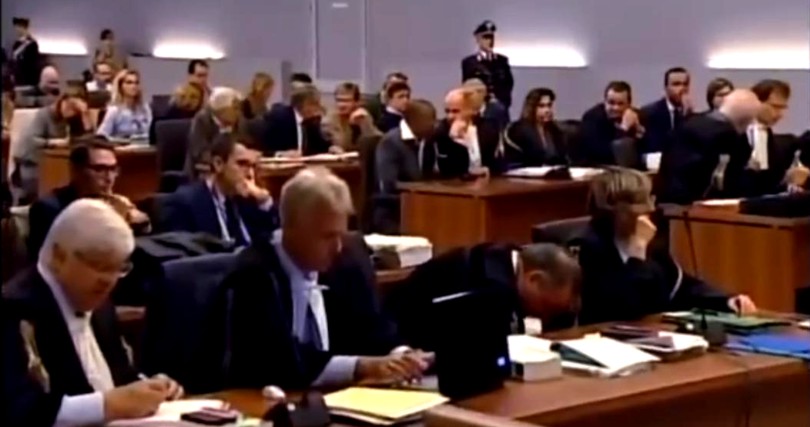
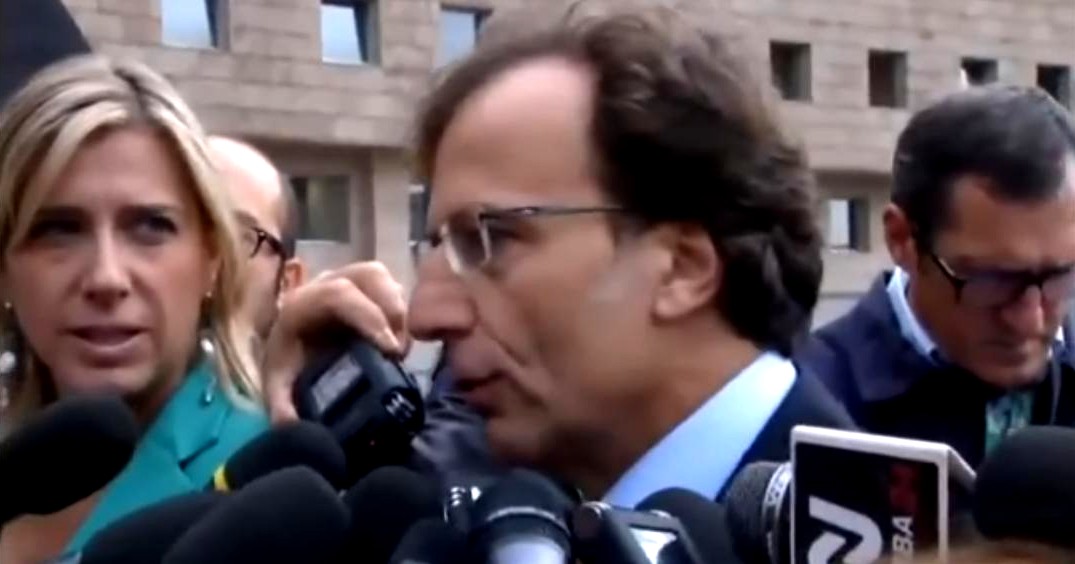
Saturday, December 14, 2013
Why Is Appeal Prosecutor Crini So Very, Very Interested In The Precise Position Of Filomena’s Door?
Posted by Cardiol MD
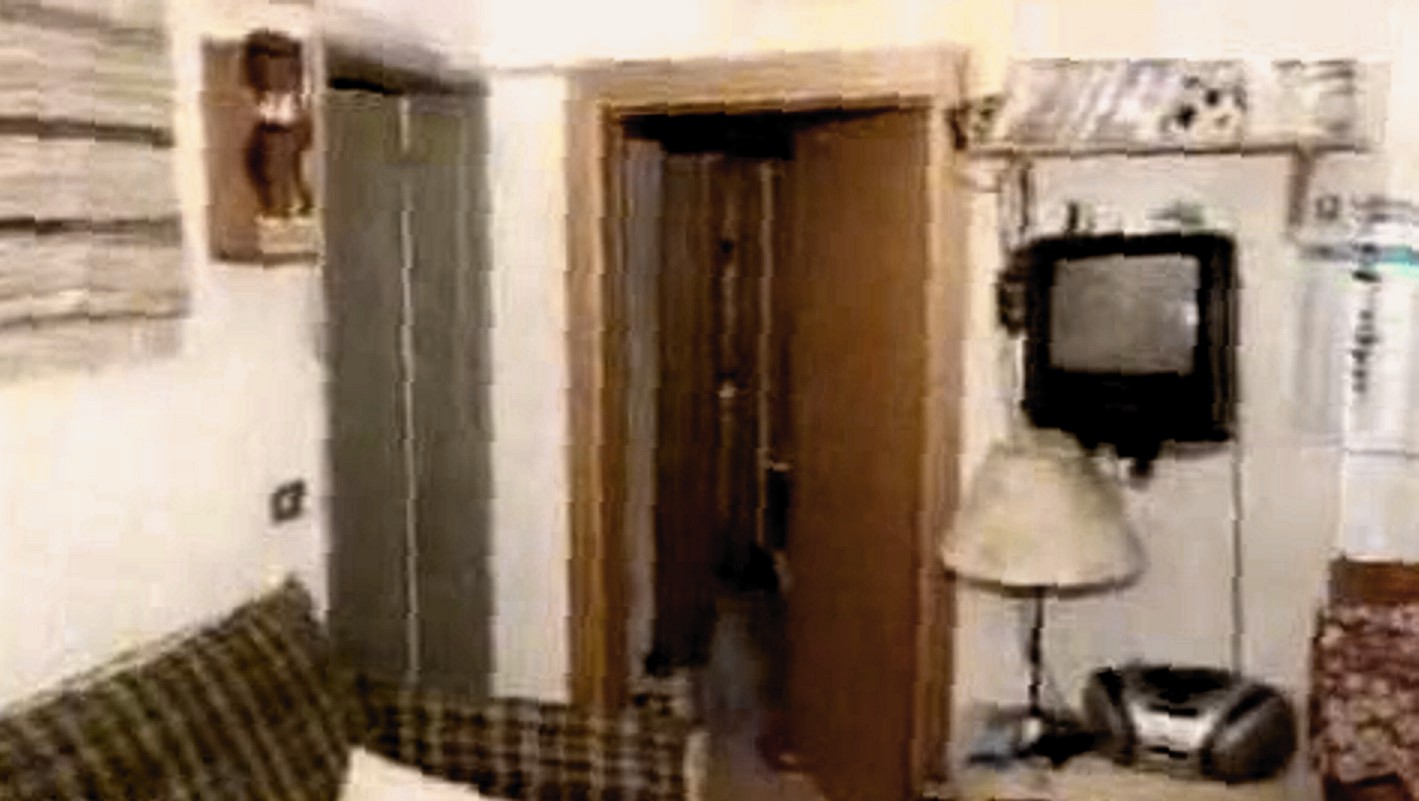
[Above, we can see Filomena’s grey door, at hard left; ahead are Meredith’s & Knox’s bedrooms]
Do please bear in mind that this appeal was initiated by Knox and Sollecito, and the verdict, sentence and sentencing report they dispute is Judge’s Massei’s from the 2009 trial.
The subject of one of Dr Crini’s focuses - whether or not Filomena’s door was open at the various times Knox and Sollecito stated they went to the women’s apartment on the morning-after ““ is a crucial one, relevant to proving Knox’s and Sollecito’s lies and obfuscations.
Wasn’t the staged break-in to Filomena Romanelli’s room glaringly obvious? In the early morning of November 2nd, 2007? In spite of the Knox/Sollecito obfuscations? There is much information in Massei on this question, pointing to many very obvious obfuscations.
Now, for the legal requirements of beyond-reasonable-doubt (BRD) actual, literal quotations are needed. Much relevant information can easily get “˜lost in translation’ not only at the superficial level of paraphrase, as in “They said that”¦..”, but also at the more subtle level of the formats used for quotations.
Some of the Massei Report as translated consists of the actual oral quotations of witness statements, some are quotations of the content of written documents, but some consist only of paraphrases of both oral statements and of written documents.
For some quotations, especially nested-quotations the translation uses various formats, beginning either with a comma or an apostrophe, ending with an apostrophe, and, in my copy, some back-slashes.
This mixture can be confusing to some readers, and Knox and Sollecito are seasoned veterans of exploiting such translational losses. That is a major factor in their continuing obstruction of justice: using chronic obfuscation.
He said, “She yelled, ‘I’m going to kill you.’ “
This quotation-format has been substituted in this post where it seems appropriate. It is hoped that when this format is used only to indicate editorial irony it will be self-evident.
John Follain and Will Savive also make a number of relevant references, and so do some Wiki articles whose authors are too modest to identify themselves though “˜Underhill’ has been mentioned as a co-ordinator.
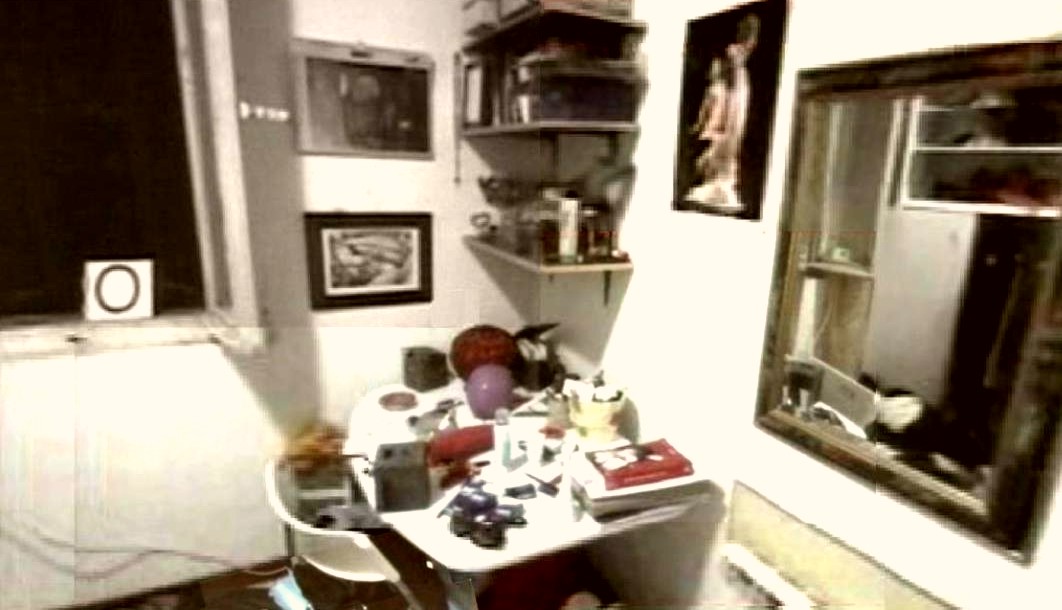
Of course, the members of the Florence Appellate Court have access-to, have probably already read, thousands of pages of evidence, including the actual verbatim witness-transcripts, and that Court will make up its own mind independent of what is written elsewhere.
Here are some of the Massei “˜door’ instances - this is a selection of a relevant 6 out of a grand total of 192 instances:
Massei Page 28: [Amanda Knox and Raffaele Sollecito ““ said that they were waiting for the carabinieri whom they had called since “coming back to the cottage in the morning because they had been away for the night” and finding “the entrance [15] door open and then the window broken” (see declarations by Battistelli, hearing of February 7, 2009, page 64).]
Access to the Court Records would help us better-understand this passage, but Follain (Page 67, Kindle location 939), indicates that Battistelli is actually quoting Sollecito, substituting “˜they’ for “˜we’, so it seems that Sollecito was already obfuscating the facts, encouraging the inference that their shocking observations began only when both he and Knox arrived together and discovered together both the open apartment entrance-door, and from inside Filomena’s room, the broken-window, so we are all being steered away, by Sollecito, from the true answer to our question.
Massei Pages 29-30: [Around midday(Nov, 2nd, 2007), at ten past twelve, when they had not yet arrived at the car park of the Fair, and she(Filomena) was in the car with her friend Paola Grande, she received a phone call: it was Amanda letting her know that there was something strange. She had arrived and had found the door open: she had had a shower and it had seemed to her that there was some blood; moreover she said that she was going [17] to Raffaele’s place (declarations of Romanelli page 31, hearing of February 7, 2009).
To her (Filomena’s) question about where Meredith was, she had answered that she did not know.]
Filomena had apparently not been told by Knox, in this 1st phone-call, about the broken pane, the stone, and the bedroom-disarray, as if Knox was not yet aware of these stunning facts. The obfuscation continues.
Massei Page 30: [Marco Zaroli, who was without a car because Ms. Romanelli had taken it, had called his friend Luca Altieri and they had gone together to the house in Via della Pergola, where they arrived around 1:00 pm, at almost the same time as Filomena Romanelli and Paola Grande. In the house there were the also the two present accused and ““ as we have seen ““ Inspector Battistelli and Assistant Marzi. The presence of the latter two was linked by Ms. Romanelli to what Amanda had told her about the open door, the broken pane, her own room in a mess.]
When Knox first told Ms. Romanelli about her visit, she had omitted reference to Laura’s and Filomena’s doors, whether they were open, whether they were openable, whether Knox opened them, and whether Knox looked inside and saw the broken pane, the stone, and the bedroom-disarray. It is implausible that Knox tried only Meredith’s door and not the others.
It is also implausible that Knox even took a shower at the women’s apartment, colder as it was than Sollecito’s. Amy Frost testified that hours after the body was discovered Amanda Knox told her that she never took the shower, because when she noticed the blood that had stopped her from showering.
The Postal Police commented that Knox also emanated an unpleasant, “˜post-shower’ odour, inconsistent with Amanda having recently had a shower anywhere, implying Knox was lying about taking the shower.
Knox is steering Ms. Romanelli away from these crucial facts which logically demanded that their “˜discoverer’ flee (again), and call the Police. Knox is obfuscating by selective piece-meal feeding-of-the-facts to Filomena.
Massei Page 38: [On the day of November 2, 2007 at police headquarters, Amanda was also there and she said that that night she had been with her boyfriend Raffaele and that the next morning at around 11:00 am she had gone back home to get changed. She had found the entrance door open and this seemed strange to her: she had gone into the house and into her room and she had taken a shower and had seen drops of blood.
She said that after the shower she got dressed and noticed that Meredith’s door was locked. She went into the other bathroom and said that there were faeces in the toilet. Then she went into another room and noticed that the window had been broken and that there was glass inside. She told these things to her and the other girls present. Then she related that she had gone back to Raffaele’s house and had rung Filomena. She remembered that on that occasion at police headquarters Raffaele was very calm, silent.]
When Knox first called Filomena, Knox had omitted any mention of the most significant information - the (staged) break-in, as if she had not ‘noticed’ it.
Now, later, paraphrasing, Massei states: “Then she went into another room and noticed that the window had been broken and that there was glass inside.”
Had Massei not paraphrased, but had written “Then I went into Filomena’s room and ‘noticed’ that her window had been broken and that there was glass inside.”, we could use it as BRD evidence.
The actual, verbatim quote should be among the many thousands of Court Records relied upon by Massei; Nencini’s Court should use such Record in reaching its decision.
Massei Page 65: [Upon returning home, she [Amanda] noticed that the door was wide open. She thought someone had gone to take the trash out or gone to the floor below, closing the door behind them but not locking it. She asked loudly whether anyone was at home, but no one answered. The door to Meredith’s room was closed, and this meant she was sleeping. She undressed in her own room and took a shower in the bathroom, (the one) nearest to (both) her room and to Meredith’s.
When she got out of the shower, she realised that on the little bath mat where she had placed her feet, there was blood and also, there were drops of blood on the sink and the faucet. She left the bathroom and went to get dressed in her own room. Then, she went in the other bathroom to dry her hair, where there was a blow dryer. It was at this time that she noticed feces in the toilet, which surprised her. She then took the mop and returned to Raffaele’s home, locking the door (on the way out.)
She told Raffaele what she had seen and he suggested that she call one of her friends. She then called Filomena Romanelli, who said that she had been out with her boyfriend and that Laura Mezzetti was also away, in Rome with her family. She then realised that the only one to have spent the night in Via della Pergola was Meredith, about whom, however, nothing was known. Filomena seemed worried, so Amanda (Page 66) told her that she would call Meredith, who would then call her back.
She then called the two cellphones that Meredith had, but without getting any response (from her). She then returned home, this time with [55] Raffaele. Upon returning home, she opened the door to Filomena Romanelli’s room and saw that the window was open and completely broken: there was chaos, “šbut her computer was in its place on the desk.”› Convinced that there had been a burglary, she went into the other rooms: Laura’s room was in order, and nothing was missing from her own room.
However, Meredith’s door was closed. She began to knock and to call out, without receiving any answer. She was then seized with panic and went on the balcony to see if she was able to see anything, but she couldn’t see anything. She went down to the apartment below to ask someone, but no one was there. She therefore went back inside and Raffaele said that he wanted to try to break down the door of Meredith’s room, but he wasn’t able to. It was then that they decided to call the police, which is what Raffaele did. She let Filomena know about this, asking her to come home.]
Now, only after returning “home, this time with [55] Raffaele.” does Knox allege that she had then “opened the door to Filomena Romanelli’s room and saw that the window was open and completely broken: there was chaos, “šbut her computer was in its place on the desk.”
Knox continues to obfuscate by selective piece-meal feeding-of-the-facts.
Massei Page 66: [While they were waiting, two police officers arrived (at the scene) and she showed them all that she had seen. Then Filomena arrived with her boyfriend and two other friends, and they broke down the door of Meredith’s room.]
True. There are a number of other Massei references to Filomena’s door and room, but they are basically repetitive of information already in the above references.
This seems to be enough for Nencini’s Court to reach its verdicts re Knox and Sollecito.
[Below: the area from which Knox would have been looking at Filomena’s door]

Thursday, December 12, 2013
Why Meredith Might Have Survived If The Attackers Had Cared And Called For Help Very Fast
Posted by Cardiol MD

Malala Yousafzai, world-famous Pakistani victim of a Taliban assassination attempt, survived via a tracheostomy
Absence of full medical picture outside Italy
For this post I wear my medical hat - I am a cardiologist who has had many lives in the balance under my hands.
Parts of the prosecution’s evidence back at trial in 2009 were very stark. Some was presented behind closed doors and with no CCTV feed, although good summaries in Italian appeared in the Italian press.
In Italy the reporting on the trial was several times as deep as anywhere else. There were TV chat shows to review the case as it was being made, and many in Italy read the entire Massei Report when the Department of Justice put it on their website.
Nobody in Italy gives the slightest credence to the theory of the Lone Wolf. Many or most have not even heard about it, and to almost all Italians the idea that Guede could have acted alone (as Knox and Sollecito claimed in their English-only books) would seem absurd.
Many Italians were therefore quick to realize that the Hellmann court did not see the prosecution present its real case, and had been led astray by cherrypicking and innuendo by the defense and an unqualified judge.
In contrast, as I said above, foreign reporting was not deep. The Massei report now being argued against by Knox and Sollecito (yes, this is THEIR appeal) has not yet been carried in English by even one non-Italian media site.
Even the amazing Massei report summary which PMF posters so carefully prepared appeared only here.
How this can affect the January outcome
Among the starkest items of the evidence that are well known in Italy but almost nowhere else are the autopsy findings and the whole-day crime scene recreation testimony.
They were presented (1) only in closed court in mid 2009 and (2) in the attack recreation video shown to the court late in 2009. during Summations. The highly effective video, which took months to get just right, was not entered into evidence and so no jury other than Massei’s has seen it since.
Closing this yawning chasm really matters now because (1) the Supreme Court is in no doubt that Guede did not act alone and (2) the Sollecito and Knox defense attempts to prove one or two other perps staged the attack with or without Guede have fallen off a cliff.
Here is the blunt truth:
- Meredith’s killers at the end inflicted terrible, terrible wounds, and witnessed what she went through.
- There is evidence that Meredith might have SURVIVED if medical help had been called very quickly indeed.
Instead of course her killers cruelly ignored her dying pain, took away her phones, locked her door, and for a while at least they simply went away, while she died.
These truths about the attack and in particular the horrific wounds is relevant both to what Meredith’s killers are guilty-of, and to what sentence would be appropriate if it is confirmed they did the deed.
Brief explanation of the medical facts
While this subject is tough for most people, it has to be viewed objectively by medical-professional care-givers and by judges, and now may be an acceptable time to objectively clarify the subject.
Such information is considered highly relevant in US courts, under Federal Rule 702. Testimony by Expert Witnesses, US state Good Samaritan Laws, and possibly in Italian courts, under Art. 593 of the criminal code ““ Failure to Provide Emergency Assistance.
Even though I can find no references to Failure to Provide Emergency Assistance in the various Motivazioni, many TMJK readers may be interested in this discussion of the subject:
MK’s airway-wound, taken in isolation, was certainly survivable for hours or even days; her superior thyroid artery wound was potentially survivable if simple manual compression was quickly applied there-and-then by anyone present, and urgent professional assistance was then obtained.
MK’s dying occupied at least as much as 15 minutes; it was the combination, and proximity of the 2 wounds that was lethal.
The kind of injury to Meredith’s airway, intentionally inflicted with malicious intent, is well within the spectrum of accidental injuries seen and treated in hospital ERs.
The elective therapeutic procedure - tracheostomy - has consequences very similar both to malicious and to purely accidental airway-injuries.
A tracheostomy is a surgical procedure to create an opening through the neck into the trachea (windpipe).
A tube is usually placed through this opening to provide an airway and to remove secretions from the lungs. This tube is called a tracheostomy tube or trach.tube.
The cutting part of the procedure is called ‘the tracheotomy’; ‘tracheostomy’ is the name assigned when the artificial tube has been inserted.
Tracheostomy is frequently performed in hospitals, all over the world. The subjects of tracheostomy cannot phonate unless the tracheostomy-opening is sealed, typically using a finger to divert the exhaled air through the larynx.
Injuries to the tracheobronchial tree within the chest may occur due to penetrating forces such as gunshot wounds, but are more often the result of blunt trauma. TBI due blunt forces usually results from high-energy impacts such as falls from height and motor vehicle accidents; the injury is rare in low-impact mechanisms.
Injuries of the trachea cause about 1% of traffic-related deaths. Other potential causes are falls from high places and injuries in which the chest is crushed. Explosions are another cause.
Gunshot wounds are the commonest form of penetrating trauma that cause TBI. Less commonly, knife wounds and shrapnel from motor vehicle accidents can also penetrate the airways.
Most injuries to the trachea occur in the neck, because the airways within the chest are deep and therefore well protected; however, up to a quarter of TBI resulting from penetrating trauma occurs within the chest. Injury to the cervical trachea usually affects the anterior (front) part of the trachea.
Notables who survived via a tracheostomy
Many public figures have received tracheostomy in the past. These are perhaps the most well-known:
- Gabrielle Giffords, a Democratic member of the United States House of Representatives received a tracheostomy after being shot in the head.
- Elizabeth Taylor had an emergency tracheostomy for pneumonia in 1961.
- Stephen Hawking (physicist) received a tracheostomy because his muscles of respiration are paralysed by Amyotrophic Lateral Sclerosis (ALS, also known as “˜Lou Gehrig’s disease’)
- Catherine Zeta Jones (actress) when a little girl, contracted a virus that prevented her from breathing normally, and underwent tracheostomy surgery.
- John Paul II (Pope) had an emergency operation after a breathing crisis
Others whose tracheostomy saved their lives
Medical and legal conclusions from this
Repair of Meredith’s airway injury was potentially survivable, given the conditions indicated in the medical text above.
It was the simultaneous severing of her right superior thyroid artery, and the failures not only to seek emergency care, but the abandonment by her attackers that resulted in her death.
The right superior thyroid artery is about the same size as the radial artery of the wrist, which when severed suicidally, leads to a similarly slow death from blood-loss alone.
In Meredith’s case, she inhaled the blood and died less slowly, by coexistent drowning.
The Nencini Court should take her killers’ Failure to Provide Emergency Assistance into account in its decisions, especially if they now try to claim it was just a prank-gone-wrong.
Malala Yousafza who survived via a tracheostomy; the tube is visible below her chin

Thursday, December 05, 2013
With Sollecito’s First Plea For Mitigation Seen As A Flop, His Behavior Seems Extremely Suspect
Posted by Peter Quennell

Sollecito headed for Dominican Republic, but stopped pending court okay
1. Post Overview
A week ago Prosecutor Crini had begun a two-day summary of the state’s case so stark and implacable that it had two effects on Sollecito.
He stayed in his hotel on the second day; and he then took off like a rabbit for some destination initially unknown and repeatedly lied-about by his father (see Part 3 below).
One of his lawyers (accidentally?) broke the secret. Sollecito had flown to the Dominican Republic. Where he just happens to have some really unsavory relatives.
2. High Drama In The Nencini Court
Sollecito has not ever taken the witness stand.
And given the minefield his foolish book and media claims amount to, don’t hold your breath expecting otherwise soon. However, last month Sollecito did use the Italian accuseds’ privilege of making an impromptu plea to the judges.
He was not under oath and not subject to cross-examination by the prosecutors. He did not address the copious evidence, and was seen as attempting to humanize himself to perhaps get some years knocked off a final sentence.
As always, Knox forces were left confused, thinking he had somehow helped both of them. But Sollecito repeatedly drew attention to his being an Italian and in effect to Knox and Guede not being Italians, thus once again separating himself from Knox on lines Barbie Nadeau also described here..
Our main poster Yummi was in the court and reported in part as follows:
One of the woman judges kept staring elsewhere and almost never watched Sollecito all the time he was talking. Sollecito’s speech itself was actually not that exciting. It was so overt that he was focused on portraying himself as a person who is so good and cannot hurt anyone, not the bad guy described in the media. The real and only topic of Sollecito’s statement was himself, who he is, his “true” personality, he begged them to look at what a good and suffering a boy he is…
And believe me, Sollecito was just whiny. For a big part of his speech he was just putting distance between who he is today and the person he was when he was 20 years old. He talked about the impossibility of finding a job (the job he would like to have in a corporation, obviously, not just any job) and wanted the judge to project to his condition from that of young Italians who can’t hope to see a future.
Then 10 days ago the skilled senior prosecutor Dr Alessandro Crini fired back, and effectively demolished Sollecito’s premature statement. As we reported, Dr Crini took nearly two days to do that.
Sollecito was again in court on the first day, but was seemingly unable to face Dr Crini’s onslaught on the second day. He remained holed up at his hotel.
Although Dr Crini settled on a lowest-common-denominator motive - a Lord of the Flies flare-up which had escalated into mob violence and the fatal stab to Meredith - his recounting of the evidence and associated behavior of the pack was comprehensive and very hard. Translated from Cronaca:
Meredith was treated “as if she was an animal.” In this way Dr Crini defined the dynamics of the murder of Meredith Kercher during his indictment.
According to Dr Crini, the attack escalated to the point where the attackers felt they “needed to get rid of a girl they had abused”. While Rudy Guede sexually abused Meredith Kercher, supine on the floor of her room, Raffaele Sollecito and Amanda Knox, according to the reconstruction, were at each side of the body of the victim.
“The mouth and neck of the victim were contained in a fierce way to avoid Meredith going berserk and screaming, and when Meredith did in fact manage to scream, she received the final fierce stab to the throat.” Two knives were used in the crime at the house in Via della Pergola on the night between 1 and 2 November 2007”...
Dr Crini referring to the bra clasp of the victim, said that “the presence of the DNA of Raffaele Sollecito is quite certain” and explained at length why there was no “possibility of contamination”.
Amanda Knox was at the scene of the crime, according to the identification made “‹”‹by the scientific police in Meredith’s room of an imprint of a shoe (female size 36-38 according to the results of the analysis)... On the pillowcase, the center of gravity of this bloody history, were found a palmprint of Rudy Guede and this print of the shoe.”
3. High Drama Right After End Of Court
Dr Francesco Sollecito was reported as being shocked by the unrelenting tone of the indictment. However, Sollecito’s plight is not nearly as bad as the ever-stubborn Amanda Knox’s.
Knox has already served three years and was fined heavily for obstruction of justice. She could face another year for that if it is found to have been aggravating. And as the post below mentions, she could face as many as three more charges for aggravating obstruction of justice.
Sollecito in contrast has respected the court by actually showing up, and, unlike Knox, has lately shown restraint in accusing his accusers.
However, the day after Dr Crini ‘s startlingly powerful summary of the case against him, it looked like Sollecito was hastily taking off out of Italy for somewhere.
La Nazione reported that police at Florence Airport had held back a fully loaded Air France flight to Paris while they checked with the prosecution that he was indeed allowed to leave the country. La Nazione said the prosecutors have some concern that he might skip and not come back, but he did voluntarily come back previously from the Dominican Republic, and his family has always ensured some presence in court.
But next TGCom24 reported that Sollecito’s father had claimed that Sollecito had already gone home to Bisceglie, although he is a free citizen still in possession of a passport and can travel anywhere if he wishes.
But then TGCom24 reported that he had indeed flown to Paris, but had turned around and come straight back again, to stay with family friends. And that on 8 December he will sit his final exams in computer science at the University of Verona.
However, soon after that La Nazione reported that Sollecito’s father had been contradicted by his lawyers, and his erratic son had slipped through his fingers and flown “for his work” back to the Dominican Republic. Translation by Jools:
1 December 2013 ““ SCOOP. Denials, lies, game by the defenders. But in the end it’s up to the lawyer Luca Maori to admit: “Raffaele Sollecito returned to Santo Domingo, as anticipated on Friday by La Nazione”
He embarked from Florence’s Peretola Airport and made a stop-over in Paris, from where he then flew to the Caribbean island where he spent the last few months that preceded the start of the new appeals process. “But there is nothing strange - minimizes the lawyer - Raffaele went back to pick up the things he left there, will be back in ten days for the final exams and to await the judgment. With anxiety, but self-assured.”
No escape, just a normal “work” trip. Permissible, since there is no measure that prevents the accused to leave Italy. But the departure of Sollecito, accused of the murder of Meredith Kercher along with former girlfriend Amanda Knox (already sheltered in the U.S.) caused some sneering. And even the agents of the Border Police, when they saw him in front of the [departure] gate, made a phone call to the Procura to be sure whether the journey in the midst of the appeal process was really “normal.”
IN FACT. Sollecito ‘s father, in an understandable effort to defend his already too overexposed son, slipped on the so-called banana peel, placing the young man within a few hours in various locations, but never in the true destination across the ocean: in Verona, preparing for the final exam in computer science in regard to the thesis, or in Paris, but just for a flash-stay from which he was back the day after. At Christmas, maintained the father, Raffaele will return from abroad. Maybe for the last break before the final rush of the Mark II process, which, according to calculations by the Assize Court of Appeal, could be concluded on January 15.
Meanwhile, the hearing on 16 December is for the remaining civil parties, then double date for the defence, (December 17 and January 9) and hearing on the 10 dedicated to counter-argument. With Sollecito in the courtroom, assures the lawyer.
Nothing strange?! Doctor Sollecito lying repeatedly, instead of explaining to the media where Raffaele went, and why he went there, and why it was a huge secret, was VERY strange.
It should have official minds very seriously wondering why. WHAT did Raffaele have to do so secretly in the Dominican Republic - where his notorious mafia relatives from Montreal occupy a town there?
Monday, December 02, 2013
A Second Analysis Of Amanda Knox’s Email To Family And Friends Of 4 November 2007 DRAFT
Posted by Peter Quennell
I have been trawling through Knox’s infamous email that she wrote to her “friends” in the US shortly after she had cruelly murdered poor Meredith. Here are my thoughts - apologies to all if I am covering old ground.
I have interspersed Knox’s email record, (as she had written it), with my own comments. Hope they are useful to TJMK’s fight for justice for Meredith.
Email by Amanda Knox
This is an email for everyone, because I’d like to get it all out and not have to repeat myself a hundred times like I’ve been having to do at the police station. Some of you already know some things, some of you know nothing.
This reads as if Knox is establishing an alibi and a chronology from the outset. The structure is an odd mix of quasi-formality and off the cuff anecdote.
She does not feel the need to explain why she has had to repeat herself a hundred times at the police station. After all, an innocent person would tell the truth once, with perhaps minor corrections. Only a person, like Knox, who was changing her story to the police so often, would need to repeat herself endlessly. By default, therefore, she is admitting that her story is proving unbelievable, so this email is her attempt to garner psychological support and credence from her family and friends in the US.
What I’m about to say, I can’t say to journalists or newspapers and I require that of anyone receiving this information as well.
Here and repeated further on in this email, Knox is blatantly breaching the strict advice that she remains publicly silent, particularly in relation to the media. She has no control over this email “information”, once she has sent it to her multiple recipients, because she cannot be sure that it will not leak to third parties.
This is my account of how I found my roommate, murdered, the morning of Friday, November 2nd.
Strictly formal in style, much as one would expect of a written statement to the police. Knox seeks to assuage her psychological turmoil and gain mental control because she knows she has repeatedly lied to the police and none has yet, (understandably), believed her.
The last time I saw Meredith, 22, English, beautiful, funny, was when I came home from spending the night at a friend’s house.
The insertion of “22, English, beautiful, funny” seems completely inappropriate in relation to a recently, brutally murdered Meredith. It reads as if a third-rate novelist is introducing a key character. Thus Knox reveals her email to be a self-serving, imaginary construct ““ not factual and honest, as an innocent person would write.
It was the day after Halloween, Thursday. I got home and she was still asleep, but after I had taken a shower and was fumbling around the kitchen, she emerged from her room with the blood of her costume (vampire) still dripping down her chin.
Showers, in this email, seem to be a major obsession for Knox. Could she be trying to wash away her oppressive psychological feelings of guilt?
We talked for a while in the kitchen, how the night went, what our plans were for the day, nothing out of the ordinary”¦..,
Why should Knox note, “Nothing out of the ordinary” in this routine conversation, other than she is trying to paint a benign landscape of her relationship with Meredith? (In fact, we know from independent witnesses that Meredith had become increasingly annoyed by Knox’s anti-social behaviour around the house)
“¦and I began to start eating a little, while i waited for my friend (Raffaele-at whose house i stayed over) to arrive at my house. He came right after I started eating and he made himself some pasta.
Note Knox’s truly strange attention to detail, “I began to start eating a little” and “He came right after I started eating”. Why the almost millisecond importance of eating? I believe that Knox is highlighting the timing of Sollecito’s arrival to establish that they were therefore together when Meredith was alive and that they remained so until her body would be discovered. This seeks to build an apparently highly accurate and continuous chronology for their alibi.
As we were eating together, Meredith came out of the shower and grabbed some laundry or put some laundry in, one or the other, and returned into her room after saying hi to Raffael
Knox mentions the word “grab” repeatedly throughout this email. It does not signify a factual rush to do something, but her psychological need to create a fleeting impression about recollections that she knows to be untrue.
It is also odd that Knox feels the need to highlight the “laundry”, but is immediately vague on whether or not it was before or after the wash. This is the sort of detail that adds nothing of factual relevance, but tends to create the impression that Knox is making it up as she goes along. Repeatedly, throughout all her statements, she fluctuates between sudden accuracy about certain unimportant facts or those that support her claimed innocence, but becomes, equally suddenly, very “confused” when it relates to important facts that might establish her guilt.
After lunch, I began to play guitar with Raffael and Meredith came out of her room and went to the door. She said bye and left for the day. It was the last time I saw her alive.
This is a very laborious and therefore insincere recall. Most innocent people would simply recall that, “After lunch, Meredith said goodbye and left for the day”. Knox’s attention to detail appears necessary only because she is carefully constructing a knowingly dishonest version of events and placing herself in it, as if she were an innocent spectator.
After a little while of playing guitar, I and Raffael went to his house to watch movies and after, to eat dinner and generally spend the evening and night indoors. We didnt go out.
Once again, Knox takes great care to build a continuous, but dishonest, alibi. She seeks to reassure herself by creating a fantasy narrative, with Sollecito and her as the key actors.
How can one “generally spend the evening and night indoors”? Either they did or they didn’t do so. Period.
Why, if they did stay in, does Knox feel the need to expressly state, “We didn’t go out”?
It would appear that Knox is grappling with her inner knowledge that she is telling whopping great lies, but by repeating them, she can establish the alibi in her mind and also reassure herself, (and the FOA), that she is telling the truth.
The next morning, I woke up around 1030 and after grabbing my few things, I left Raffael’s apartment and walked the five-minute walk back to my house to, once again, take a shower and grab a change of clothes.
As above, we have two instances of “grabbing”, indicating a specific desire to skip quickly across her conscious lies. Knox again stresses a shower, a subconscious effort to cleanse her burdensome knowledge of guilt.
I also needed to grab a mop because, after dinner, Raffael had spilled a lot of water on the floor of his kitchen by accident and didnt have a mop to clean it up.
This is not the first time that Knox alludes to this water issue and therefore, the need to collect the mop from her house. Unfortunately, Sollecito’s and her versions vary between a “spillage” and a “leak” from the sink.
These descriptions mean two different things. A “spillage” indicates a human cause, whereas a leak indicates a failure in the pipes.
Judge Massei has rightly questioned the need to collect a mop from Knox’s house, when Sollecito had a janitor service at his house.
I don’t think anyone on TJFM has suggested a perhaps more likely reason for Knox “grabbing” her mop and taking it to Sollecito’s house, one that has nothing to do with leaks or spillages at the latter house.
We know that there was a concerted clean-up of the murder scene, most likely after Knox had purchased cleaning agents/bleach from the shop, early on the morning of November 2nd 2007. It would make sense that Knox and Sollecito, bare foot, used Knox’s house mop to wash down the floors. It would be potentially very risky to leave that mop at the murder scene thereafter, (no matter how well it was rinsed), for fear that traces of Knox’s and/or Solliceto’s incriminating DNA remained for detection by forensics, mixed with Meredith’s DNA.
It was simply much safer to take the mop away, as they left the house.
It would be interesting to know if the police ever found Knox’s original mop and whether it would have yielded any incriminating DNA evidence.
So, I arrived home and the first abnormal thing I noticed was the door was wide open.
Note: Knox immediately notes that the “wide open” door was “abnormal”.
Here’s the thing about the door to our house:
It’s broken, in such a way that you have to use the keys to keep it closed.
if we dont have the door locked, it is really easy for the wind to
blow the door open and so my roommates and I always have the door
locked unless we are running really quickly to bring the garbage out
or to get something from the neighbors, who live below us.
Who “runs really quickly” to bring garbage out? Only someone like Knox, who is trying to persuade herself and the FOA that it would justify leaving an entrance door “wide open”. Most sensible tenants would have demanded that the landlord repair the door and secure the property, particularly as it housed four young women.
(Another important piece of information: for those who dont know, I inhabit a
house of two stories, of which my three roommates and I share the
second story appartment. there are four Italian guys of our age
between 22 and 26 who live below us. We are all quite good friends and we talk often. Giacomo is especially welcome because he plays guitar with me and Laura, one of my roommates and is, or was, dating Meredith. The other three are Marco, Stefano, and Ricardo.)
Why is this information so “important”, particularly for “those who don’t know”? The only reason seems to be an opportunity for Knox to create the illusion that she was very sociable. We know, according to independent witnesses, that Knox had distinct character quirks that made social contact uncomfortable for all who met her, (bar Solliceto).
Anyway, so the door was wide open. Strange, yes, but not so strange that I really
thought anything about it.
Note: now Knox cannot make up her mind whether the “wide-open” door is “odd/strange” or “not so strange that I really thought anything about it”. The truth is that these expressed reactions are mutually exclusive. Indeed, she goes on immediately to show that she DID think something about it”¦.
I assumed someone in the house was doing exactly what I just said, taking out the trash or talking really quickly to the neighbors downstairs. So I closed the door behind me
but I didnt lock it, assuming that the person who left the door open would like to come back in.
A lot of “thinking” here, all of it a self-serving excuse as to why Knox didn’t call the police straight away.
When I entered, I called out if anyone was there, but no one responded and I assumed that if anyone was there, they were still asleep.
This was another of Knox’s BIG assumptions, taking no care to even consider that there might have been a genuine break-in or that the culprit might be still lurking in the house.
Laura’s door was open which meant she wasn’t home, and Filomena’s door was also closed. My door was open like always and Meredith door was closed, which to me meant she was sleeping.
Knox seems to be so knowledgeable about her housemates’ whereabouts, simply by the status of their respective bedroom doors!
In fact, Knox knew that both Filomena and Laura would be away for the long weekend and that only Meredith would be in the house on 01/11/2007.
I undressed in my room and took a quick shower in one of the two
bathrooms in my house, the one that is right next to Meredith and my
bedrooms, (situated right next to one another).
It was after I stepped out of the shower and onto the mat that I noticed the blood in the
bathroom. It was on the mat I was using to dry my feet and there were
drops of blood in the sink.
At first, I thought the blood might have come from my ears, which I had pierced extensively not too long ago, but then, immediately, I know it wasn’t mine because the stains on the mat
were too big for just droplets from my ear, and when I touched the
blood in the sink it was caked on already.
Who pierces their ears “extensively”? Knox, here, is desperate to try to link bleeding from alleged tiny earlobe punctures with the volume of blood visible in the sink and on the mat.
There was also blood smeared on the faucet. Again, however, I thought it was strange
because my roommates and I are very clean and we wouldn’t leave blood
in the bathroom, but I assumed that perhaps Meredith was having
menstral issues and hadn’t cleaned up yet. Ew, but nothing to worry
about.
Again, lots of “strange” blood that Knox immediately seeks to explain away by careless and indeed ridiculous “menstral” bleeding.
More importantly, note here that Knox only considers that she and/or Meredith could be the only source of the blood. She had arrived back to a “wide-open” door, which could have allowed any bleeding person to enter the bathroom unimpeded.
In fact, Knox is grappling again with her knowledge that the blood is a mixture of Meredith’s and her own DNA. By suggesting her bleeding ear piercings and Meredith’s “menstral issues”, Knox is making a feeble attempt to put together an innocent, advance explanation for any mixture of Meredith’s and her blood that subsequent forensic examination might identify.
Still, Knox shows not the slightest concern that her house is “wide-open” and there is blood in the bathroom. An innocent person would have immediately contacted her housemates, accounted for their safety and then called the police.
I left the bathroom and got dressed in my room. After I got
dressed, I went to the other bathroom in my house, the one that
Filomena and Laura use, and used their hairdryer to obviously dry my
hair”¦
Why does Knox state “”¦.obviously to dry my hair”? Why otherwise would anyone normally use a hair dryer?
“¦ and it was after I was putting back the dryer that I noticed the
shit that was left in the toilet, something that definitely no one in
our house would do.
NOTE: Knox confirms here that she first noticed the “shit” in Filomena and Laura’s toilet and that it could not be that of any of the housemates.
I started feeling a little uncomfortable.
Only a “little”? How many indications did Knox need to conclude that something was seriously amiss? Still, she made no call to the police or her housemates.
Note again that she only “started” to feel uncomfortable ““ no more than that. She constantly seeks to express her alleged concern on one hand and simultaneously write it off on the other.
and so I grabbed the mop from out closet and left the house, closing and locking the door that no one had come back through while I was in the shower, and I returned to Raffael’s place.
This is another “grabbing” remark to skip over another deliberate untruth. It also seems to imply that her discomfort made her leave the house in a hurry, (see below).
How does Knox know whether or not anyone had come in through the open door, while she was in the shower?
After we had used the mop to clean up the kitchen, I told Raffael about what I had seen in the house over breakfast. The strange blood in the bathroom, the door wide open, the
shit left in the toilet. He suggested I call one of my roommates, so I
called Filomena.
So here we have Knox, having left her house feeling “uncomfortable” for all the reasons that she stated in this paragraph, but then goes to Sollecito’s house where she and Sollecito allegedly “cleaned up the kitchen”, (note: not “”¦.mopped up the water spillage/leak”).
They then make breakfast and it is only “over breakfast” that Knox gets round to sharing this troubling and uncomfortable information with Sollecito.
An honest person would have told Sollecito straight away, upon her return. Why was Knox so nonchalant about the “strange” things at her house? Perhaps because she and Sollecito, (as the murderers), already knew all about them and that she is now constructing this fantasy alibi to cover their guilty asses.
Filomena had been at a party the night before with her boyfriend, Marco, (not the same Marco who lives downstairs but we’ll call him Marco-f as in Filomena and the other can be Marco-n as in neighbor).
She also told me that Laura wasn’t at home and hadn’t been
because she was on business in Rome. which meant the only one who had
spent the night at our house last night was Meredith, and she was as
of yet unaccounted for.
Knox therefore confirms that she already knew that both Filomena and Laura were out of town for the long weekend. Filomena testified that she had asked Amanda, on the afternoon of 01/11/2007, to help her wrap a birthday present for the party.
Filomena seemed really worried, so I told her I’d call Meredith and then call her back.
Knox seems quite surprised at the extent of Filomena’s worried response. The real surprise is that Knox is the only one, of all the housemates and Meredith’s friends, who behaved in a totally inappropriate and cold manner, both leading up to the discovery of Meredith’s body and particularly afterwards at the police station.
The phone record shows that Knox is telling more lies here ““ she had already rung Meredith’s phones before ringing Filomena.
Judge Massei found that Knox had done so, not out of any concern about Meredith, (the calls only lasted 3 or 4 seconds), but to establish that the discarded phones had not yet been found. Having satisfied herself that the phones remained undiscovered and that no investigation could yet be underway, the coast was clear for Knox to ring Filomena and thereby set the wheels in motion of the inevitable discovery of Meredith’s body.
I called both of Meredith’s phones, the English one first and last and the Italian one between.
No, this was BEFORE Knox first called Filomena, (see above). The phone record completely destroys Knox’s alleged call chronology and proves her, without doubt, to be a liar.
The first time i called the English phone, it rang and then sounded as if
there was disturbance, but no one answered.
What kind of “disturbance”? Was Knox trying to imply that someone else had the phone at that stage?
I then called the Italian phone and it just kept ringing, no answer.
I called her English phone again and this time an English voice told me her phone was out of
service.
Oh well, Knox, never mind”¦.
Raffael and I gathered our things and went back to my house.
I unlocked the door and I’m going to tell this really slowly to get
everything right, so just have patience with me.
Revealingly, Knox had to warn herself to be careful here ““ she wouldn’t want a slip up in her alibi, would she? No innocent person would ever have the need to write such a phrase.
The living room/kitchen was fine. Looked perfectly normal. I was checking for
signs of our things missing, should there have been a burglar in our
house the night before.
Why did she not do this when she had first gone to her house earlier that morning?
Filomena’s room was closed, but when I opened the door, her room was a mess and her window was open and completely broken, but her computer was still sitting on her desk like, it always was and this confused me.
Yes, Knox, of course it did, but you bravely persevered with your search”¦
Convinced that we had been robbed, I went to Laura’s room and looked quickly in, but it was spotless, like it hadn’t even been touched. This, too, I thought was odd.
This alleged robbery becomes even more strange for Knox ““ “convincing” but at the same time, “odd”. The only explanation, (which she knew and was discovering more and more flaws in it), was that it was a “staged” break-in of Sollecito’s and her own making.
I then went into the part of the house that Meredith and I share and checked my room
for things missing, which there weren’t.
Phew, that must have been a relief! Most (innocent) people would have checked their own room first.
Then I knocked on Meredith’s room, but when she didnt respond. I knocked louder and louder until I was really banging on her door and shouting her name. No response.
Either Meredith wasn’t in, (the most likely reason) but she had not answered her phones.
Why did Knox not call the police immediately?
Panicking, I ran out onto our terrace to see if maybe I could see over the ledge into her
room from the window, but I couldn’t see in. Bad angle.
The “angle” was the same as it had always been. It was only a small house. Why did Knox allegedly try to see through Meredith’s window when it was out of the line of sight from the terrace?
I then went into the bathroom where I had dried my hair and looked really quickly
into the toilet. In my panic, I thought I hadn’t seen anything there,
which to me meant whoever was in my house had been there when I had
been there.
As it turns out, the police told me later that the toilet was full and that the shit had just fallen to the bottom of the toilet, so I didnt see it.
Why, in a state of panic, did Knox suddenly decide to inspect the toilet bowl in Filomena’s bathroom? Knox has already written, (see above, in this discussion), that she had noticed the unusual “shit” in the toilet during her first visit to the house earlier that morning.
Why would the police discuss with Knox the position of the “shit” as a means of helping her to understand why she had completely failed to notice it in her “panic”?
Knox deduces that whoever had left the shit in the bowl had been there when she was there. It turned out to be Guede’s shit, therefore Knox is admitting that she was with Guede on the night of Meredith’s murder and Guede has been convicted of the crime - one for which he is co-responsible with Knox and Sollecito.
I ran outside and down to our neighbors’ door. The lights were out, but I banged on the door anyway. I wanted to ask them if they had heard anything the night before, but no one was
home. I ran back into the house.
Knox knew that the boys downstairs were going away for the long weekend before she murdered Meredith. Why would Knox have pounded of the door of a house that she had known was empty?
In the living room, Raffael told me he wanted to see if he could break down Meredith’s door. He tried, and cracked the door, but we couldn’t open it. It was then that we decided
to call the cops.
What a wimp! The housemates’ boyfriends, when they discovered that Meredith was missing and that her door (unusually) locked, had no trouble breaking down the door and unlike Sollecito, they were not trained in kick-boxing.
Finally, they called the cops!! Knox did so with no urgency whatsoever. She and Sollecito delayed calling the police for as long as possible, to give themselves time to construct an agreed alibi and to check that everything was in place, at the murder scene, to indicate a “lone wolf” break in and attack on Meredith.
There are two types of cops in Italy, Carabinieri, (local, dealing with traffic and domestic calls) and the police investigators.
He first called his sister for advice and then called the Carbanieri.
I then called Filomena, who said she would be on her way home immediately.
Knox is a liar here again. These remarks are unsupported by the phone record.
While we were waiting, two ununiformed police investigators came to our house. I showed them what I could and told them what I knew. Gave them phone numbers and explained a bit in broken Italian, and then Filomena arrived with her boyfriend, Marco-f
and two other friends of hers.
These uniformed police confirmed that both Knox and Sollecito looked very surprised to see them. Neither of them knew that the phones had been discovered, (ironically one had been discovered when Knox had rung it a little earlier), and that these police had arrived to investigate their loss and return them to Filomena and Meredith.
No word from Knox as to why she and Sollecito were surprised to see these police.
All together, we checked the house out, talked to the police and in a bit, they all opened Meredith’s door.
I was in the kitchen, standing aside, having really done my part for
the situation. But when they opened Meredith’s’ door and I heard
Filomena scream, “a foot! a foot!”, in Italian, I immediately tried to
get to Meredith’s room, but Raffael grabbed me and took me out of the
house.
This is a complete fabrication. Knox speaks as someone who knew that the opened bedroom door would reveal Meredith’s body. No innocent person would stand back, aloof and disinterested, when all the others were anxious to break down the door.
Which innocent person would lapse into complete disinterest because “I had already done my part for the situation”. Sounds as if Knox felt she had acted that part of the planned alibi script and was waiting to resume the act at a later stage.
Knox then tries to establish that she tried to get to Meredith’s room because Filomena had screamed “a foot”. Again, Sollecito saved the day by “grabbing”, (that word again!), her and taking her outside because Filomena had screamed out “a foot”.
It is a fact that both Knox and Sollecito obviously knew details of the murder scene, but had not been present to see into the bedroom when the door had been broken down.
Thus, Knox is trying here to establish how she knew about the disposition of Meredith’s body, without needing a line of sight on the murder scene.
The police told everyone to get out and not long afterward the
Carabinieri arrived and then soon afterward, more police
investigators. They took all of our information and asked us the same
questions over and over.
The police had not asked the same questions “over and over” of any other, (innocent), witnesses, just of Knox and Solliceto. Why? I suspect that only Knox and Sollecito needed repeated questions because only they were telling inconsistent and changing stories.
Knox simply does not understand that the police only tend to ask the same questions “over and over” if the witness is being dishonest and evasive by giving inconsistent and contradictory answers. She may as well admit that her answers were and are just that.
At the time, I had only what I was wearing and my bag, which thankfully had my passport in it and my wallet. No jacket though, and I was freezing.
Was Knox trying to cover up her nervous trembles, during her answers to difficult questions, by trying to claim here that she was “freezing”?
After sticking around at the house for a bit, the police told us to go to the station to give testimony, which I did.
I was in a room for six hours straight after that, without
seeing anyone else, answering questions in Italian for the first hour
and then they brought in an interpreter and he helped me out with the
details that I didnt know the words for..
An innocent person would never submit to an interview in a murder case, without fluency in the local language
Knox repeats here the allegations of extended questioning and sleep/food/water deprivation to try to excuse her admissions in her signed, written statements. The facts show that she had only about three hours of questioning, the remainder of the time at the police station being spent on giving long, voluntary accounts of her part in the events, at her request.
No person EVER admits to a callous murder, except perhaps under overt torture. Knox has never claimed torture during questioning.
They asked me, of course, about the morning, the last time I saw her, and because I was the closest to her, questions about her habits and her relationships.
Here, Knox is attempting to create an untruthful impression of a close and warm relationship with Meredith. Meredith’s friends consistently claim to the contrary.
Afterwards, when they were taking my fingerprints, I met two of
Meredith’s English friends, two girls she goes out with, including the
last one who saw her alive that night she was murdered. They also had
their prints taken.
After that, (this was around 9 at night by this time), I was taken into the waiting room where there was various other people who I all knew from various places, who all knew Meredith. Her friends from England, my roommates, even the owner of the pub she most
frequented.
After a while, my neighbors were taken in too, having just arrived home from a weeklong vacation in their home town, which explained why they weren’t home when I banged on their door.
Of course it did, Knox. You knew that the neighbours had gone away for the weekend. In fact, as you knew that only Meredith would be in the house, it was a perfect opportunity to assault and murder her.
Later than that, another guy showed up and was taken in for questioning, a guy I
dont like, but whom both Meredith and I knew from different occasions, a
Moroccan guy that I only know by his nickname amongst the girls,
“shaky”.
Big, bad BLACK guy, that is, not an all-American, sweet, apple pie gal like good ole Amanda…
Then I sat around in this waiting room, without having the
chance to leave or eat anything besides vending machine food, (which
gave me a hell of a stomach ache) until 5:30 in the morning.
Knox made no official complaint about this alleged mistreatment by the police. On the contrary, she confirmed, in court, that the police had treated her well, including supplying food and drinks to her. More lies.
During this time, I received calls from a lot of different people, family
mostly of course, and I also talked with the rest, especially to find
out what exactly was in Meredith’s room when they opened it. Apparently
her body was lying under a sheet, and with her foot sticking out and
there was a lot of blood. Whoever had done this had slit her throat.
Here, Knox records another explanation of how she knew about the crime scene details, while never having been in the position to see them. These are lies, again, of course.
They told me to be back in at 11am. I went home to Raffael’s place,
ate something substantial and passed out.
Altogether, what with the murder, staged break in, intensive overnight cleanup of the murder scene, giving consistently contradictory evidence to the police and maintaining an aura of sweet innocence, I am not surprised that Know alleges that she “passed out”. She must have been knackered. Photos of the pair on the morning after the murder show both to be drawn and unkempt.
In the morning, Raffael drove me back to the police station, but had to
leave me when they said they wanted to take me back to the house for
questioning.
Before I go on, I’d like to say that I was strictly told not to speak about this, but I’m speaking with you people who are not involved and who can’t do anything bad except talk to journalists, which I hope you won’t do. I have to get this off my chest because it’s
pressing down on me and it helps to know that someone besides me knows
something and that I’m not the one who knows the most out of everyone.
Why does Knox reveal information here, about which she had been “strictly told” not to speak? This shows her unwillingness to accept any boundaries in her behaviour.
What is pressing on Knox’s chest? The guilt of having murdered Meredith or more likely, that she cannot persuade anyone, (outside the FOA), to believe her changing stories and denials of fact.
Knox inadvertently concedes here that she “”¦ knows the most out of everyone”. I would suggest that the only way to know that much is to be the murderess.
Pathetically, she is seeking to share her guilt by passing the buck of responsibility onto others, who by swallowing her stories, hook, line and sinker, can become witting or unwitting co-conspirators in her deception.
At the house, they asked me very personal questions about Meredith’s
life and also about the personalities of our neighbors. How well did I
know them? Pretty well, we are friends. Was Meredith sexually active?
Yeah, she borrowed a few of my condoms. Does she like anal? WTF? I
dont know. Does she use Vaseline for her lips? What kind of person is
Stefano? Nice guy, has a really pretty girlfriend.
I have no doubt that Knox could fill in any gaps in her knowledge here by telling her usual lies, as she always has done and continues to do.
Hmmm”¦very interesting. We’d like to show you something, and tell us if this is
out of normal.
Why would the police rely on Knox for an honest answer to ANY question?
They took me into the neighbors’ house. They had broken the door open
to get in, but they told me to ignore that.
Why would the police have broken the door down, rather than simply call the young men home and keep their part of the house sealed off until they had arrived?
The rooms were all open. Giacomo’s and Marco-n’s rooms were spotless, which made sense because the guys had thoroughly cleaned the whole house before they left on
vacation.
This is Knox reaching quick conclusions on matters about which she has no knowledge. How ironic that she cannot reach any consistent and revealing conclusion about Meredith’s murder, about which she knows so much
!
Stefano’s room however, well, his bed was stripped of linens,
which was odd, and the comforter he used was shoved up at the top of
his bed, with blood on it. I obviously told then that the blood was
definitely out of normal and also that he usually has his bed made.
They took note of it and ushered me out.
How can Knox be such an expert about Stephano’s room, his blood and his personal habits? More lies and fantasy.
When I left the house to go back to the police station, they told me to put my jacket over my head and duck down below the window, so the reporters wouldn’t try to talk to
me.
At the station, I just had to repeat the answers that I had given
at the house, so they could type them up and after a good 5 and a half
hour day with the police again, Raffael picked me up and took me out
for some well-deserved pizza. I was starving.
Again, Knox admits that she has to answer the same, repeated questions, oblivious to the fact that this must imply that her answers are inconsistent and God Forbid, dishonest.
I then bought some underwear because, as it turns out, I won’t be able to leave Italy for a
while, as well as enter my house. I only had the clothes I was wearing the day it began, so i bought some underwear and borrowed a pair of pants from Raffael.
So Knox only buys underwear because she cannot leave Italy or enter the house? Does she not need any other clothes?
Spoke with my remaining roommates that night (last night) and it was a hurricane of emotions and stress, but we needed it anyway.
I would suspect Knox, more than anybody, to be at the centre of the “hurricane”. Innocent people would be upset for Meredith’s loss, but would not experience anything like Knox’s stress, as a murderess trying to concoct a consistent alibi, without success.
What we have been discussing is basically what to do next. We are trying to keep
our heads on straight.
Knox, here, is admitting that she was exercised in keeping her concentration on the next phase of maintaining her concoction of lies.
First things first though, my roommates both work for lawyers, and they are going to try to send a request through on Monday to retrieve important documents of ours that are still in
the house.
These “documents” were obviously much more important than Meredith’s murder. Knox is such a narcissist ““ everything is all about her.
Secondly, we are going to talk to the agency that we used to find our house and obviously request to move out. It kind of sucks that we have to pay the next month’s rent, but the owner has protection within the contract.
Such a shame! Obviously Knox did not foresee that murdering Meredith might cost her a month’s extra rent.
After that, I guess I’ll go back to class on Monday, although I’m not sure what I’m going to do about people asking me questions, because I really dont want to talk again about what
happened. I’ve been talking an awful lot lately and I’m pretty tired of
it. After that, it’s like I’m trying to remember what I was doing before
all this happened. I still need to figure out who I need to talk to and what I need to do to continue studying in Perugia, because it’s what I want to do.
Yes, Knox, don’t let your murder of Meredith interrupt your study and future plans.
Anyway, that’s the update, feeling okay,
Better now for off-loading all this rubbish? Here’s a bit of advice, Knox, if you truly wish to offload your burden, tell the truth of your involvement in Meredith’s cruel murder.
Hope you all are well,
Amanda.
Yeah - right!
Saturday, November 30, 2013
Note For Strasbourg Court & State Department: Knox Herself Proves She Lies About Her Interrogation
Posted by James Raper

In our previous post Kermit nicely shows how, under the European Court of Human Rights’ own guidelines, Amanda Knox’s “appeal” won’t put her out of reach of the fair and painstaking Italians.
If any of the busy, hard-pressed ECHR investigators do choose to press beyond the ECHR guidelines, they will almost instantly establish that in her voluntary interview on 5 November 2007 Knox was treated with complete fairness.
Also that her false accusation of Patrick (which she never retracted) was entirely of her own doing.
And also that she is not only trying to throw sand into the wheels of Italian justice during an ongoing judicial process (a felony in Italy) but she is trying to welsh out of paying Patrick his damages award of $100,000 (a contempt of the Supreme Court) thus foolishly risking two more charges of aggravated calunnia.
This post derives from a post of mine last May. In another post, we showed that Dr Mignini was not present for the interrogation that night, and Knox maliciously invented an illegal interrogation at risk of a third aggravated calunnia charge.
In fact Dr Mignini met with Amanda Knox only briefly, later, to charge her and to warn she should say no more without a lawyer. He asked her no questions.
I will compare the various accounts of the interrogation to demonstrate that Amanda Knox is indeed lying to the ECHR, just as she did repeatedly in her book this year and also on US and European television.
- There are two main bodies of truth about the interrogation: (1) all of those present at various times on that night and (2) Knox’s own testimony on the witness stand in mid 2009.
- There are two main bodies of lies about the interrogation (1) The Sollecito book and (2) the Knox book, which by the way not only contradict one another but also contradict such other accounts as those of Saul Kassin and John Douglas.
The police had called her boyfriend Raffaele Sollecito in to the station for questioning and Knox had accompanied him because she did not want to be alone. They had already eaten at the house of a friend of Sollecito’s.
Knox’s interrogation was not tape recorded and in that sense we have no truly independent account of what transpired. The police, including the interpreter, gave evidence at her trial, but we do not yet have transcripts for that evidence other than that of the interpreter. There are accounts in books that have been written about the case but these tend to differ in the detail. The police and the interpreter maintain that she was treated well. Apart from the evidence of the interpreter all we have is what Knox says happened, and our sources for this are transcripts of her trial evidence and what she wrote in her book. I shall deal with the evidence of the interpreter towards the end of this article.
I am going to compare what she said at trial with what she wrote in her book but also there was a letter she wrote on the 9th and a recording of a meeting with her mother on the 10th November which are relevant.. What she wrote in her book is fairly extensive and contains much dialogue. She has a prodigious memory for detail now which was almost entirely lacking before. I am going to tell you to treat what she says in her book with extreme caution because she has already been found out for, well let us say, her creative writing if not outright distortion of facts. I shall paraphrase rather than quote most of it but a few direct quotes are necessary.
Knox arrived with Sollecito at the police station at about 10.30 pm (according to John Follain). The police started to question Sollecito at 10.40 pm (Follain).
In her book Knox describes being taken from the waiting area to a formal interview room in which she had already spent some time earlier. It is unclear when that formal questioning began. Probably getting on for about 11.30pm because she also refers to some questions being asked of her in the waiting room following which she did some stretches and splits. She then describes how she was questioned about the events over a period from about the time she and Sollecito left the cottage to about 9 pm on the 1st November.
Possibly there was a short break. She describes being exhausted and confused. The interpreter, Knox says, arrived at about 12.30 am. Until then she had been conversing with the police in Italian.
Almost immediately on the questioning resuming -
“Monica Napoleoni, who had been so abrupt with me about the poop and the mop at the villa, opened the door. “Raffaele says you left his apartment on Thursday night,” she said almost gleefully. “He says that you asked him to lie for you. He’s taken away your alibi.””
Knox describes how she was dumfounded and devastated by this news. She cannot believe that he would say that when they had been together all night. She feels all her reserves of energy draining away. Then -
“Where did you go? Who did you text?” Ficarra asked, sneering at me.
“I don’t remember texting anyone.”
They grabbed my cell phone up off the desk and scrolled quickly through its history.
“You need to stop lying. You texted Patrick. Who’s Patrick?”
“My boss at Le Chic.”
Stop right there.
How were the police able to name the recipient of the text? The text Patrick had sent her had already been deleted from Knox’s mobile phone by Knox herself and Knox hasn’t yet named Patrick. In fact she couldn’t remember texting anyone.
It is of course probable that the police already had a log of her calls and possibly had already traced and identified the owner of the receiving number for her text, though the last step would have been fast work.
In her trial testimony Knox did a lot of “the police suggested this and suggestd that” though it is never crystal clear whether she is accusing the police of having suggested his name. But she is doing it here in her book and of course the Knox groupies have always maintained that it was the police who suggested his name to her.
The following extract from her trial testimony should clear things up. GCM is Judge Giancarlo Massei.
GCM: In this message, was there the name of the person it was meant for?
AK: No, it was the message I wrote to my boss. The one that said “Va bene. Ci vediamo piu tardi. Buona serata.”
GCM: But it could have been a message to anyone. Could you see from the message to whom it was written?
AK: Actually, I don’t know if that information is in the telephone”¦”¦”¦”¦”¦”¦”¦..
GCM : But they didn’t literally say it was him!
AK : No. They didn’t say it was him, but they said “We know who it is, we know who it is. You were with him, you met him.”
GCM : Now what happened next? You, confronted with the message, gave the name of Patrick. What did you say?”
AK : Well, first I started to cry…....
And having implied that it was the police who suggested Patrick’s name to her, she adds”¦.. that quote again -
“You need to stop lying. You texted Patrick. Who’s Patrick?”
“My boss at Le Chic.”
Here she is telling the Perugian cops straight out exactly to whom the text was sent. “My boss at Le Chic”.
But that does not quite gel with her trial testimony -
And they told me that I knew, and that I didn’t want to tell. And that I didn’t want to tell because I didn’t remember or because I was a stupid liar. Then they kept on about this message, that they were literally shoving in my face saying “Look what a stupid liar you are, you don’t even remember this!”
At first, I didn’t even remember writing that message. But there was this interpreter next to me who kept saying “Maybe you don’t remember, maybe you don’t remember, but try,” and other people were saying “Try, try, try to remember that you met someone, and I was there hearing “Remember, remember, remember…..
Doesn’t the above quote make it clear that the police were having considerable trouble getting Knox to tell them to whom her text message was sent? It would also explain their growing frustration with her.
But perhaps the above quote relates not to whom the text was sent but, that having been ascertained, whether Knox met up with that person later? Knox has a habit of conflating the two issues. However there is also the following quote from her trial testimony -
Well there were lots of people who were asking me questions, but the person who had started talking with me was a policewoman with long hair, chestnut brown hair, but I don’t know her. Then in the circle of people who were around me, certain people asked me questions, for example there was a man holding my telephone, and who was literally shoving the telephone into my face, shouting “Look at this telephone! Who is this? Who did you want to meet?”
Then there were others, for instance this woman who was leading, was the same person who at one point was standing behind me, because they kept moving, they were really surrounding me and on top of me. I was on a chair, then the interpreter was also sitting on a chair, and everyone else was standing around me, so I didn’t see who gave me the first blow because it was someone behind me, but then I turned around and saw that woman and she gave me another blow to the head.
The woman with the long hair, chestnut brown hair, Knox identifies in her book as Ficarra. Ficarra is the policewoman who started the questioning particularly, as Knox has confirmed, about the texted message. “Look at this telephone! Who is this? Who did you want to meet?” Again, surely this is to get Knox to identify the recipient of the text, not about whether she met up with him?
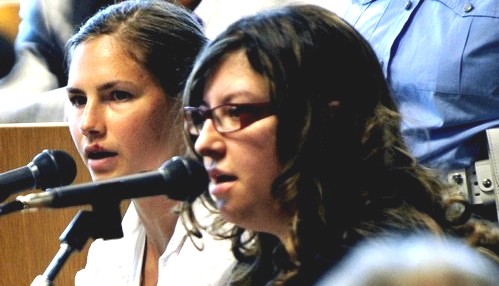
In the book though, it is all different.
In the book, the police having told her that the text is to someone called Patrick, Knox is a model of co-operation as, having already told them that he is her boss at Le Chic, she then gives a description of him and answers their questions as to whether he knew Meredith, whether he liked her etc. No reluctance to co-operate, no memory difficulties here.
Notwithstanding this, her book says the questions and insinuations keep raining down on her. The police insist that she had left Sollecito’s to meet up with - and again the police name him - Patrick.
“Who did you meet up with? Who are you protecting? Why are you lying? Who’s this person? Who’s Patrick?”
Remember again, according to her trial testimony the police did not mention Patrick’s name and Knox still hasn’t mentioned his name. But wait, she does in the next line -
“I said “Patrick is my boss.””
So now, at any rate, the police have a positive ID from Knox regarding the text message and something to work with. Patrick - boss - Le Chic.
Knox then refers to the differing interpretations as to what “See you later” meant and denies that she had ever met up with Patrick that evening. She recalls the interpreter suggesting that she was traumatized and suffering from amnesia.
The police continue to try to draw an admission from Knox that she had met up with Patrick that evening - which again she repeatedly denies. And why shouldn’t she? After all, she denies that she’s suffering from amnesia, or that there is a problem with her memory. The only problem is that Sollecito had said she had gone out but that does not mean she had met with Patrick.
Knox then writes, oddly, as it is completely out of sequence considering the above -
“They pushed my cell phone, with the message to Patrick, in my face and screamed,
“You’re lying. You sent a message to Patrick. Who’s Patrick?”
That’s when Ficarra slapped me on my head.”
A couple of blows (more like cuffs) to the head (denied by the police) is mentioned in her trial testimony but more likely, if this incident ever happened, it would have been earlier when she was struggling to remember the text and to whom it had been sent. Indeed that’s clear from the context of the above quotes.
And this, from her trial testimony -
Remember, remember, remember, and then there was this person behind me who—it’s not that she actually really physically hurt me, but she frightened me.”
In the CNN TV interview with Chris Cuomo, Knox was asked if there was anything she regretted.
Knox replied that she regretted the way this interrogation had gone, that she wished she had been aware of her rights and had stood up to the police questioning better.
Well actually, according to the account in her book, she appears to have stood up to the police questioning with a marked degree of resilience and self- certainty, and with no amnesia. There is little of her trademark “being confused”.
So why the sudden collapse? And it was a sudden collapse.
Given the trial and book accounts Knox would have us think that she was frightened, that it was due to exhaustion and the persistent and bullying tone of the questioning, mixed with threats that she would spend time in prison for failing to co-operate. She also states that -
(a) she was having a bad period and was not being allowed to attend to this, and
(b) the police told her that they had “hard evidence” that she was involved in the murder.
Knox has given us a number of accounts as to what was actually happening when this occurred.
In a letter she wrote on the 9th November she says that suddenly all the police officers left the room but one, who told her she was in serious trouble and that she should name the murderer. At this point Knox says that she asked to see the texted message again and then an image of Patrick came to mind. All she could think about was Patrick and so she named him (as the murderer).
During a recorded meeting with her mother in Capanne Prison on the 10th November she relates essentially the same story.
In her book there is sort of the same story but significantly without mention of the other officers having left the room nor mention of her having asked to see the texted message again.
If the first two accounts are correct then at least the sense of oppression from the room being crowded and questions being fired at her had lifted.
Then this is from her book -
In that instant, I snapped. I truly thought I remembered having met somebody. I didn’t understand what was happening to me. I didn’t understand that I was about to implicate the wrong person. I didn’t understand what was at stake. I didn’t think I was making it up. My mind put together incoherent images. The image that came to me was Patrick’s face. I gasped. I said his name. “Patrick””it’s Patrick.
It’s her account, of course, but this “Patrick - It’s Patrick” makes no sense at this stage of it unless it’s an admission not just that she had met up with Patrick but that he was at the cottage and involved in Meredith’s death.
And this is from her trial testimony -
GCM : Now what happened next? You, confronted with the message, gave the name of Patrick. What did you say?
AK : Well, first I started to cry. And all the policemen, together, started saying to me, you have to tell us why, what happened? They wanted all these details that I couldn’t tell them, because in the end, what happened was this: when I said the name of Patrick I suddenly started imagining a kind of scene, but always using this idea: images that didn’t agree, that maybe could give some kind of explanation of the situation.
There is a clear difference between these two quotes.
The one from her book suggests that she was trying hard but that the police had virtually brought her to the verge of a mental breakdown.
Her trial testimony says something else; that a scene and an idea was forming in her mind brought on by her naming of Patrick.
In her book she states that a statement, typed up in Italian, was shoved under her nose and she was told to sign it. The statement was timed at 1.45 am. The statement was not long but would probably have taken about twenty minutes to prepare and type.
The statement according to Knox -
... I met Patrick immediately at the basketball court in Piazza Grimana and we went to the house together. I do not remember if Meredith was there or came shortly afterward. I have a hard time remembering those moments but Patrick had sex with Meredith, with whom he was infatuated, but I cannot remember clearly whether he threatened Meredith first. I remember confusedly that he killed her.
The fact that the statement was in Italian is not important. Knox could read Italian perfectly well. However she does insinuate in the book that the details in the statement were suggested to her and that she didn’t bother to read the statement before signing.
Apart from what has been mentioned above, there are some other points and inferences to be drawn from the above analysis.
- 1. Knox’s account destroys one of Sollecito’s main tenets in his book Honour Bound. Sollecito maintains that he did nothing to damage Knox’s alibi until he signed a statement, forced on him at 3:30 am and containing the damaging admission that Knox had gone out. But Knox makes it clear that she had heard from the Head of the Murder Squad that he had made that damaging admission, at or shortly after 12.30 am. Or is Knox is accusing Napoleoni of a bare-faced lie?
2. It is valid to ask why Knox would not want to remember to whom the text had been sent. Who can see into her mind? Perhaps Knox realized that discussion of it would confirm that if she had indeed gone out then it was not to Le Chic, where she was not required. However even if she thought that could put her in the frame it’s not what an innocent person would be too worried about. Perhaps she did just have difficulty remembering?
3. If there was no fuss and she did remember and tell the police that the text was to Patrick, and the questioning then moved on to whether she met up with Patrick later that evening, what was the problem with that? She knew the fact that she hadn’t met up with him could be verified by Patrick. She could have said that and stuck to it. The next move for the police would have been to question Patrick. They would not have had grounds to arrest him.
4. Knox stated in her memorial, and re-iterates it in her book, that during her interrogation the police told her that they had hard evidence that she was involved in Meredith’s murder. She does not expand on what this evidence is, perhaps because the police did not actually tell her. However, wasn’t she the least bit curious, particularly if she was innocent? What was she thinking it might be?
5. I can sympathise with any interviewee suffering a bad period, if that’s true. However the really testy period of the interview/interrogation starts with the arrival of the interpreter, notification of Sollecito’s withdrawal of her alibi and the questioning with regard to the text to Patrick, all occurring at around 12.30 am. There has to be some critical point when she concedes, whether to the police or in her own mind, that she’d met “Patrick”, after which there was the questioning as to what had happened next. Say that additional questioning took 20 minutes. Then there would be a break whilst the statement is prepared and typed up. So the difficult period for Knox, from about 12.30 am to that critical point, looks more like about 35 to, at the outside, 50 minutes.
6. Even if, for that period, it is true that she was subjected to repeated and bullying questions, and threats, then she held up remarkably well as I have noted from her own account. It does not explain any form of mental breakdown, let alone implicating Patrick in murder. In particular, if Knox’s letter of the 9th and the recording of her meeting with her mother on the 10th are to believed, that alleged barrage of questions had stopped when she implicated Patrick. An explanation, for what it’s worth, might be that she had simply ceased to care any longer despite the consequences. But why?
7. A better and more credible explanation is that an idea had indeed formed suddenly in her mind. She would use the revelation about the text to Patrick and the consequent police line of questioning to bring the questioning to an end and divert suspicion from her true involvement in the murder of Meredith Kercher. She envisaged that she would be seen by the police as a helpless witness/victim, not a suspect in a murder investigation. As indeed was the case initially. She expected, I am sure, to be released, so that she could get Sollecito’s story straight once again. If that had happened there would of course remain the problem of her having involved Patrick, but I dare say she thought that she could simply smooth that over - that it would not be a big deal once he had confirmed that there had been no meeting and that he had not been at the cottage, as the evidence was bound to confirm.
At the beginning I said that we also have a transcript now of the evidence of the interpreter, Anna Donnino. I will summarise the main points from her evidence but it will be apparent immediately that she contradicts much of what Knox and her supporters claim to have happened.
Donnino told the court that she had 22 years experience working as a translator for the police in Perugia. She was at home when she received a call from the police that her services were required and she arrived at the police station at just before 12.30 am, just as Knox said. She found Knox with Inspector Ficarra. There was also another police officer there whose first name was Ivano. At some stage Ficarra left the room and then returned and there was also another officer by the name of Zugarina who came in. Donnino remained with Knox at all times
The following points emerge from her testimony :-
- 1. Three police officers do not amount to the “lots of people” referred to in Knox’s trial testimony, let alone the dozens and the “tag teams” of which her supporters speak.
2. She makes no mention of Napoleoni and denied that anyone had entered the room to state that Sollecito had broken Knox’s alibi. (This is not to exclude that this may have happened before Donnino arrived)
3. She states that Knox was perfectly calm but there came a point when Knox was being asked how come she had not gone to work that she was shown her own text message (to Patrick). Knox had an emotional shock, put her hands to her ears and started rolling her head and saying “It’s him! It’s him! It’s him!”
4. She denied that Knox had been maltreated or that she had been hit at all or called a liar.
5. She stated that the officer called Ivano had been particularly comforting to Knox, holding her hand occasionally.
6. She stated that prior to the 1.45 am statement being presented to Knox she was asked if she wanted a lawyer but Knox said no.
7. She stated that she had read the statement over to Knox in english and Knox herself had checked the italian original having asked for clarification of specific wording.
7. She confirmed that that she had told Knox about an accident which she’d had (a leg fracture) and that she had suffered amnesia about the accident itself. She had thought Knox was suffering something similar. She had also spoken to Knox about her own daughters because she thought it was necessary to establish a rapport and trust between the two of them.
The account in Knox’s book is in some ways quite compelling but only if it is not compared against her trial testimony, let alone the Interpreter’s testimony: that is, up to the point when she implicates Patrick in murder. At that point no amount of whitewash works. The Italian Supreme Court also thought so, upholding Knox’s calunnia conviction, with the addition of aggravating circumstances.
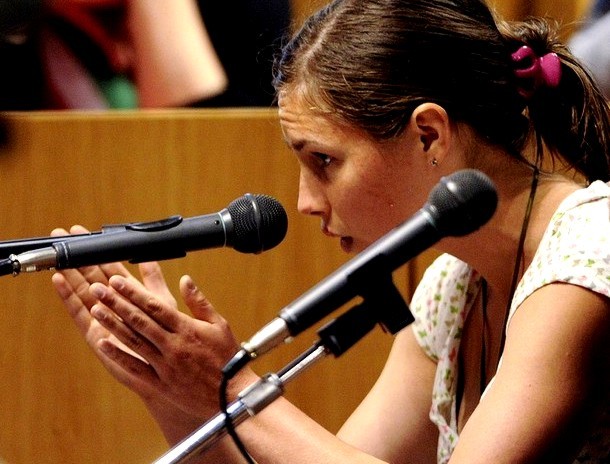
Wednesday, November 27, 2013
Amanda Knox Lies Again To Get Herself Into Another European Court “But Really, Judge, Its Only PR”
Posted by Kermit
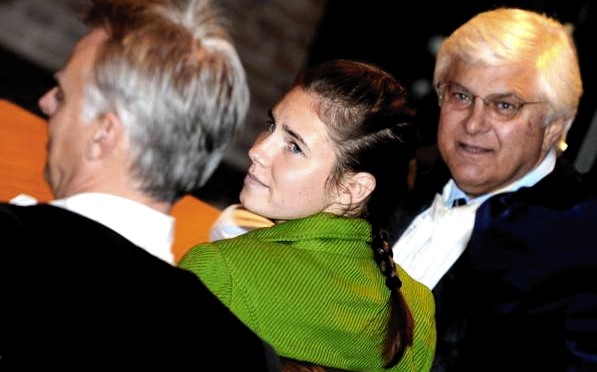
[Amanda Knox’s lawyer Luciano Ghirga (right): “Amanda wasn’t hit, we made no complaint”]
Introduction
This is the first of two posts on Knox’s claim to have sent an appeal to the Strasbourg-based European Court of Human Rights (ECHR).
Last Monday the main event that followers of the Meredith Kercher murder case were awaiting was the closing argument by Prosecutor Alessandro Crini in Amanda Knox’s and Raffaele Sollecito’s appeal trial.
Dr Crini’s structuring of the prosecution’s case in 16 points demolished the defendants’ efforts to present the volume of evidence against them as an incredible, long series of mistakes, coincidences and misunderstandings.
It seems, however, that Amanda Knox and her people didn’t want the public to be too fascinated by Dr Crini’s devastating argument. They really wanted them to be distracted by what can only be seen as an ill-judged public relations move, breaking yet more laws along the way.
Knox attempted to blow smoke over the prosecution’s arguments by grandly announcing “today, my lawyers filed an appeal of my slander[sic] conviction with the European Court of Human Rights.” That explanation of her PR ploy calls for a close review of her eligibility (here) and her so-called proof (next post).
Knox’s eligibility or otherwise
The European Court of Human Rights, is a supranational European tribunal dedicated to ““ as its name suggests - human rights.
It is not dedicated to criminal or civil proceedings on murder, sexual assault, theft, simulation of a crime, or any of the other charges that Knox faces.
In fact, to avoid the many unnecessary or spurious applications which hamper real cases getting attended to, the ECHR provides a number of online resources on who may apply and how and why.
One of the first issues that its advice underlines is that it is not a glorified appeals court:
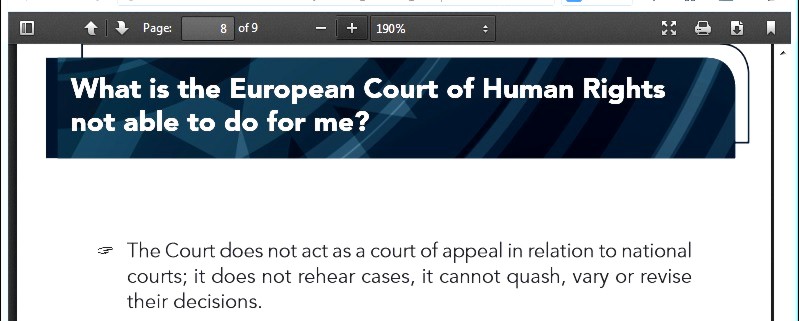
It is strange then, that Amanda Knox claims that her lawyers have “appealed” her case to the ECHR.
Either Knox’s legal advisors are just ignorant (which ones? The Italian professionals, or the American media hacks?) or this is simply a last-ditch Hail Mary action as an extradition request moves inexorably closer.
If the ECHR makes clear that it isn’t a court of appeal, there shouldn’t be any direct correlation between the Supreme Court confirming her as a convicted criminal and her application to the ECHR.
If that is in fact the basis of their application, it will not go far before rejection. In fact, the vast majority (more than 95%) of applications get rejected:
“For a number of years now, and owing to a variety of factors, the Court has been submerged by individual applications (over 130,000 were pending as at 31 August 2010). The overwhelming majority of these applications (more than 95%) are, however, rejected without being examined on the merits for failure to satisfy one of the admissibility criteria laid down by the Convention.
This situation is frustrating on two counts.
Firstly, as the Court is required to respond to each application, it is prevented from dealing within reasonable time-limits with those cases which warrant examination on the merits, without the public deriving any real benefit.
Secondly, tens of thousands of applicants inevitably have their claims rejected, often after years of waiting.”
It would be a outrageous if other, real human rights cases were delayed due to a Public Relations ruse as part of an extra-judicial strategy to undermine a request for Knox’s extradition.
Other ECHR on-line resources help potential applicants decide if they be eligible to be heard at the Court.
Below, a work-flow chart presents the main steps, including various “Admissibility Criteria”:
A first admissibility criterion
The first Admissibility criterion is that an applicant has exhausted “domestic remedies” in pursuing the recognition and correction of the human rights he or she feels have been abused.
Knox in her application to the ECHR directly relates the Italian Supreme Court final confirmation of her “calunnia” sentence (three years for obstruction of justice for framing her kindly boss Patrick Lumumba as the murderer of Meredith Kercher, thereby throwing off the course of the investigation) to her application to the ECHR.
But what were the supposed human rights abuses suffered? What did she do to remedy them?
The first requirement of exhausting “domestic remedies” means that the rights abuses that Knox alleges she has suffered have been pursued in Italy, and that all possible instances of reclamation in Italy have been visited.
However, as far as the public knows, Knox has not even placed a formal complaint concerning supposed civil rights abuse. Certainly her own Italian lawyers have said they havent.
The US and Italian publics would be interested in seeing her specific claims to the ECHR and whether there is any registration of such claims or complaints with the Italian police or other administrative or NGO offices.
Knox’s needling stepfather, Chris Mellas, stated in April 2008 on a precursor to the PMF discussion forum that a complaint had been filed concerning Amanda being hit during questioning.
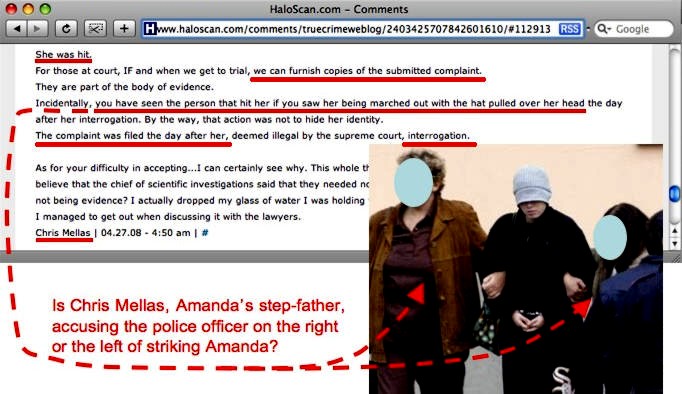
[Click for larger version]
However, nothing more has ever been heard of this complaint, which definitely would have been a starting point for pursuing domestic Italian remedies to the claimed rights abuse.
Since it appears zero rights abuses have been pursued in Italy, and the date of Knox’s application to the ECHR is in effect unrelated to her “calunnia” sentence confirmed by the Supreme Court, the six month limit beyond national remedies related to the rights abuse for applying to the ECHR is irrelevant here.
It should be noted that when Prosecutor Crini asked this week for an addition to Knox’s confirmed sentence for “calunnia”, adding another year to the three years already served by the convicted criminal, this is not a reopening of the “calunnia” case or an example of “double jeopardy”, but rather the reassessment on appeal of a separate, pending issue related to the basic calunnia charge: whether it should include an additional year of sentence for being aggravated.
Since this aggravation addition to the charge is awaiting determination, and follows from instructions of the Italian Supreme Court (and could result in an additional year in prison), it is not part of the prior, confirmed sentence.
A second admissibility criterion
Now just in case Knox or her lawyers would like to allege any perceived human rights abuse whatsoever in their ECHR application, the Strasbourg court insists on the reclamation in question being directly related to one of the sections of the European Convention on Human Rights
I’ve gone through it and I see chapters related to illegal detention (detention permitted only following arrest) and torture, but nothing related to getting cuffed on the back of your head.
If such an event ever occurred, it shouldn’t have, but quite likely one of the other authorities or rights bodies listed by the ECHR may be better equipped to deal with it.
This is a second Admissibility Criterion that filters out many applications: one can’t simply run to the ECHR saying “my rights have been abused” ““ the issue at hand must be directly related to the European Convention on Human Rights.
I seriously doubt the “hitting” event ever occurred because Knox’s own Italian lawyer Luciano Ghirga denied it, stating to the Press on 21 October 2008:
Amanda wasn’t hit. There were pressures fom the police, sure, but we never said she was hit.
As our next post here on this same subject will show, even Knox herself admitted she was treated well.
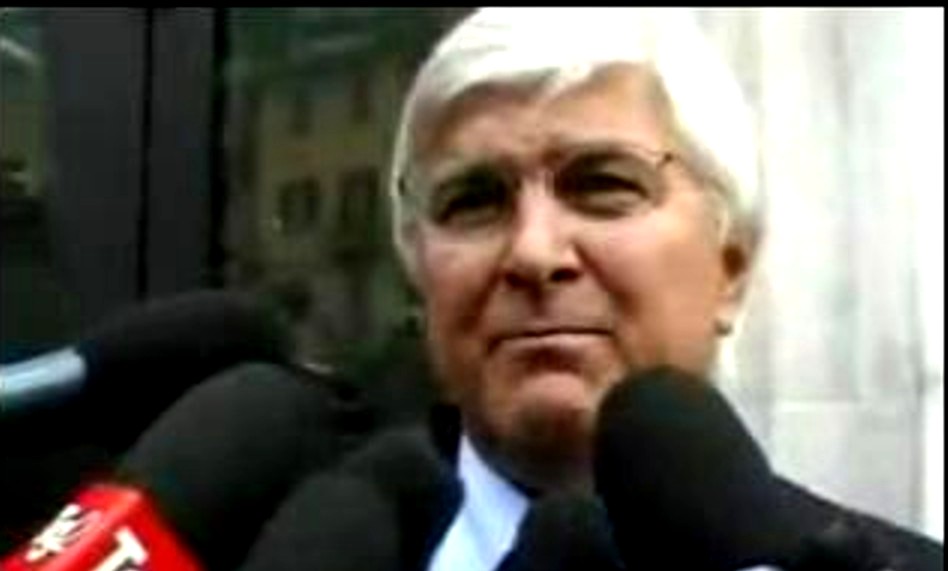
[Above: Amanda Knox’s Italian courtroom lawyer stating to the Press in 2008 that she had not been hit.]
If Knox hasn’t even tried to remedy being allegedly hit in Italy by suing or making formal complaints, nevertheless the Italian police certainly have acted upon such suggestions.
A number of legal processes are under way against Knox and her family members for slander and calunnia. Knox might face two more charges of aggravated calunnia. Why do I doubt that Knox has even mentioned those other legal processes in her application to the ECHR?
Those charges would of course have to be taken care of (as part of “exhausting domestic remedies”) before the ECHR would be able to consider her application, assuming it surmounted all of its other shortcomings to get to the ECHR judges’ hands.
A third admissibility criterion
Another Admissibility Criteria is the “Significant Disadvantage” filter. If an alleged rights abuse is minimal ““ compared to the very serious issues that the ECHR was created to consider ““ the application will go no further.
The only violent description of Knox’s alleged beating was given by her stepfather, Chris Mellas: “She was interrogated, and hit, and threatened,” he typed. “Tortured. Physically and mentally”.
However, there was never any medical or forensic notification of such “torture” before or after her incarceration in Capanne Prison.
Rather, Knox spent her time in prison receiving regular visits from a lovelorn Italian politician who befriended her, and participating in prison musical and theatrical activities.
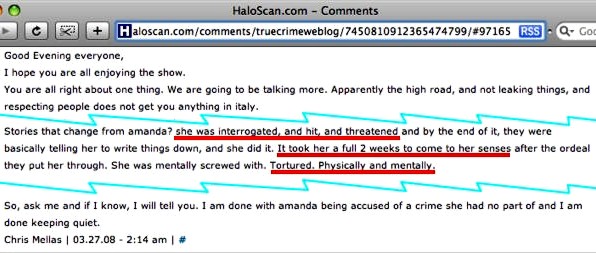
[Click for larger version]
In underlying the “significant disadvantage” requirement, the ECHR states in its examples of rejected claims, that it can’t be distracted by the French driver who lost a point on his driver’s licence, or the Romanian who claims 90 euros from the State, when the Court has real and serious Human Rights cases to deal with such as:
- El-Masri v. the former Yugoslav Republic of Macedonia (Article 3 of European Convention on Human Rights: Torture and inhuman and degrading treatment during and following applicant’s extraordinary rendition to CIA)
- Hirsii Jamaa and others v. Italy (Article 4 of Protocol No. 4: Return of migrants intercepted on the high seas to country of departure)
It’s almost certain that Knox has not pursued on an Italian level any remedies to her alleged human rights abuse (whatever it was), nor is there any evidence that the investigation into Meredith Kercher’s murder and the subsequent trials of Knox, Rudy Guede and Raffaele Sollecito were affected in their outcome by the rights abuse.
This is especially the case if the limit of Knox’s human rights suffering is that described by a talky ex-FBI helicopter pilot turned ex-college security guy turned Amanda Knox groupie, Steve Moore.
Moore describes the “frightful” circumstances of Knox’s witness questioning on the night of 5 November 2007 for the couple of hours (perhaps even somewhat less) that it lasted:
No food, no coffee, no bathroom breaks ““ nothing.
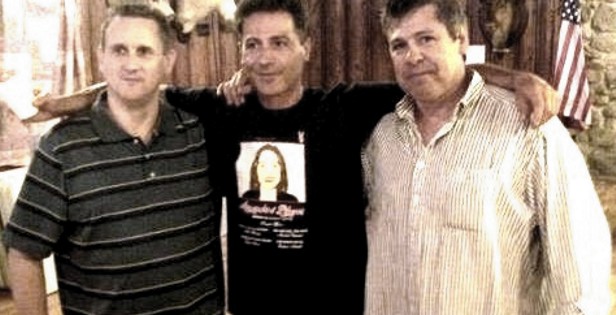
Above is ex-college security man Steve Moore, right, together with PR flunkie Bruce Fischer, left, both flanking “Frank Sfarzo”, a Knox-Mellas family friend.
Francesco Sforza is currently a fugitive from the Seattle courts on two counts of Assault-Domestic Violence, who continues to support Amanda in ongoing Internet blog posts, from wherever he may be.
See below. Click for larger. In purple, my corrections to Knox’s “what-I-want-the-World-to-believe” post about applying to the ECHR.
In conclusion
Between the manifest doubtfulness of the acceptability of Knox’s application to the European Court of Human Rights, on one hand, and the falsehoods and half-truths in her announcement, on the other, why do I get the feeling that the only reason and hope she and her team have in announcing the application (whether really filed or not) is to distract the attention of the followers of her appeal trial from the prosecution’s weighty arguments?
This will have little if any effect on the wheels of Italian Justice, and probably even less on a State Department more concerned with maintaining good relations with European allies while diplomatic challenges occur in the Middle East and Asia, than with a lobby plan to prevent Knox’s extradition.
[Below: The European Court of Human Rights in Strasbourg France]
